Change Management in Coca-Cola: Analysis and Impact
VerifiedAdded on 2023/03/20
|17
|4994
|23
AI Summary
This report analyzes the need for change in Coca-Cola, the impact of change drivers on the company, and the effects on leadership, teams, and individuals. It also discusses the pros and cons of different leadership styles in change management.
Contribute Materials
Your contribution can guide someone’s learning journey. Share your
documents today.
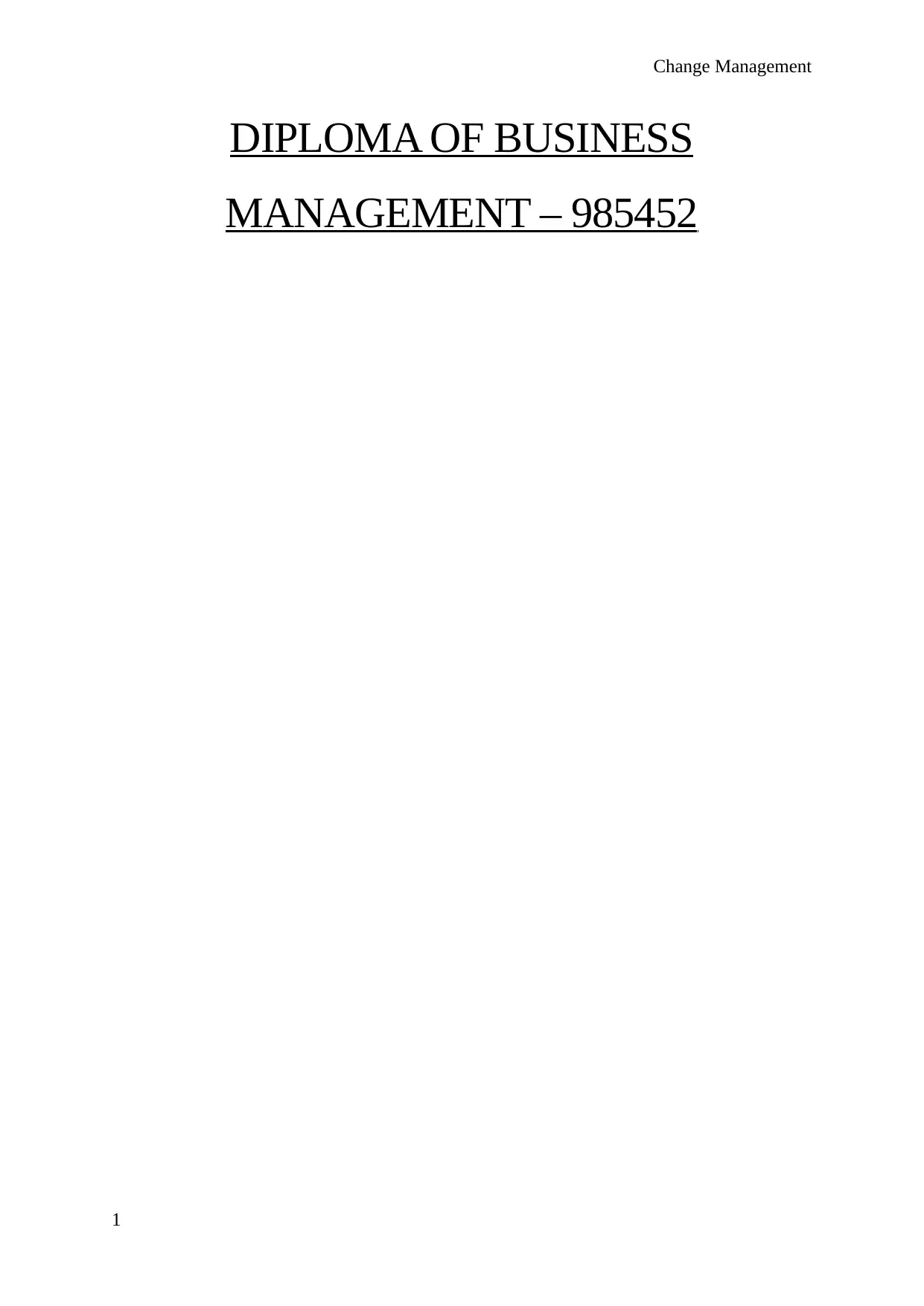
Change Management
DIPLOMA OF BUSINESS
MANAGEMENT – 985452
1
DIPLOMA OF BUSINESS
MANAGEMENT – 985452
1
Secure Best Marks with AI Grader
Need help grading? Try our AI Grader for instant feedback on your assignments.
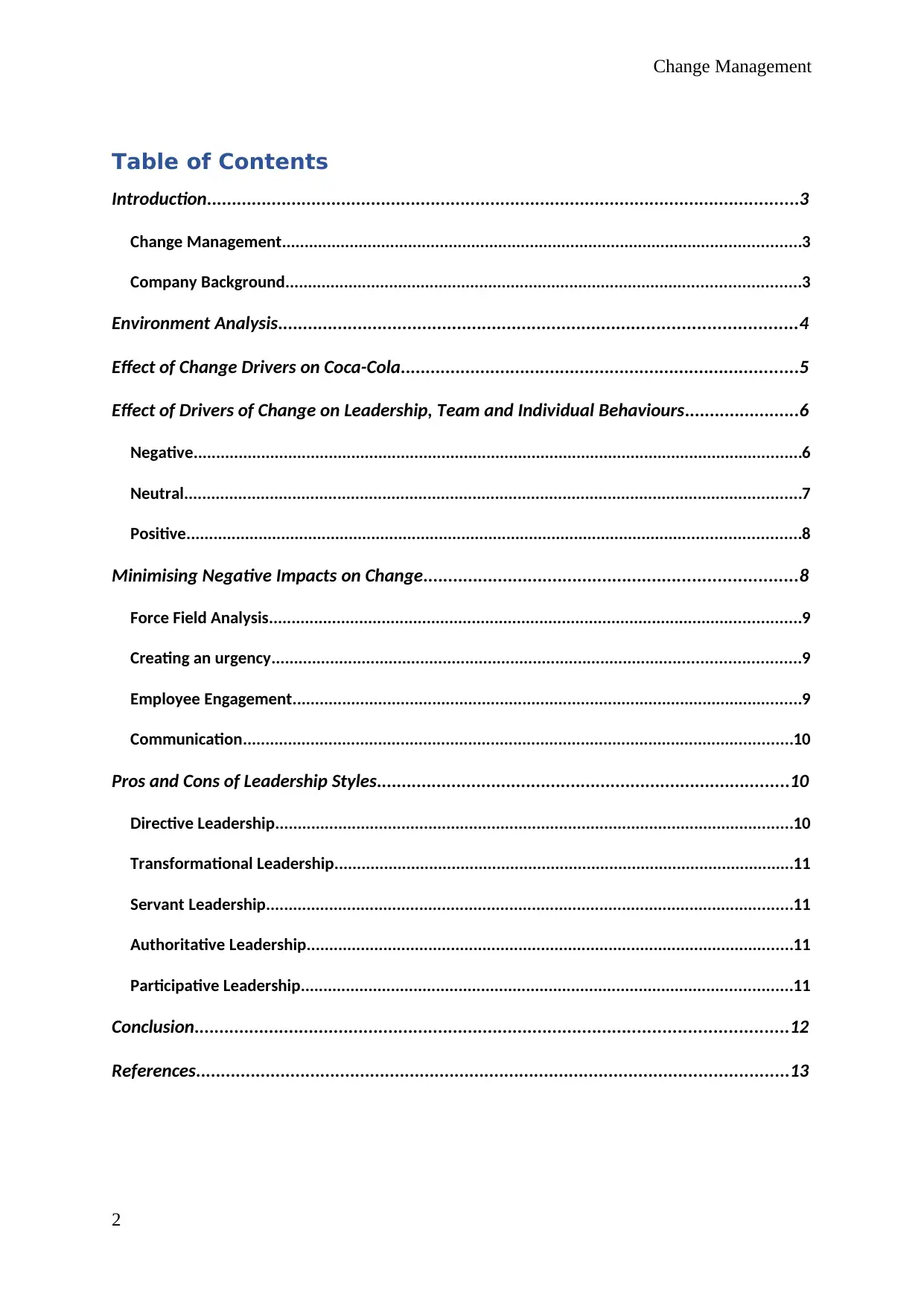
Change Management
Table of Contents
Introduction.......................................................................................................................3
Change Management...................................................................................................................3
Company Background..................................................................................................................3
Environment Analysis........................................................................................................4
Effect of Change Drivers on Coca-Cola................................................................................5
Effect of Drivers of Change on Leadership, Team and Individual Behaviours.......................6
Negative.......................................................................................................................................6
Neutral.........................................................................................................................................7
Positive........................................................................................................................................8
Minimising Negative Impacts on Change...........................................................................8
Force Field Analysis......................................................................................................................9
Creating an urgency.....................................................................................................................9
Employee Engagement.................................................................................................................9
Communication..........................................................................................................................10
Pros and Cons of Leadership Styles...................................................................................10
Directive Leadership...................................................................................................................10
Transformational Leadership......................................................................................................11
Servant Leadership.....................................................................................................................11
Authoritative Leadership............................................................................................................11
Participative Leadership.............................................................................................................11
Conclusion.......................................................................................................................12
References.......................................................................................................................13
2
Table of Contents
Introduction.......................................................................................................................3
Change Management...................................................................................................................3
Company Background..................................................................................................................3
Environment Analysis........................................................................................................4
Effect of Change Drivers on Coca-Cola................................................................................5
Effect of Drivers of Change on Leadership, Team and Individual Behaviours.......................6
Negative.......................................................................................................................................6
Neutral.........................................................................................................................................7
Positive........................................................................................................................................8
Minimising Negative Impacts on Change...........................................................................8
Force Field Analysis......................................................................................................................9
Creating an urgency.....................................................................................................................9
Employee Engagement.................................................................................................................9
Communication..........................................................................................................................10
Pros and Cons of Leadership Styles...................................................................................10
Directive Leadership...................................................................................................................10
Transformational Leadership......................................................................................................11
Servant Leadership.....................................................................................................................11
Authoritative Leadership............................................................................................................11
Participative Leadership.............................................................................................................11
Conclusion.......................................................................................................................12
References.......................................................................................................................13
2
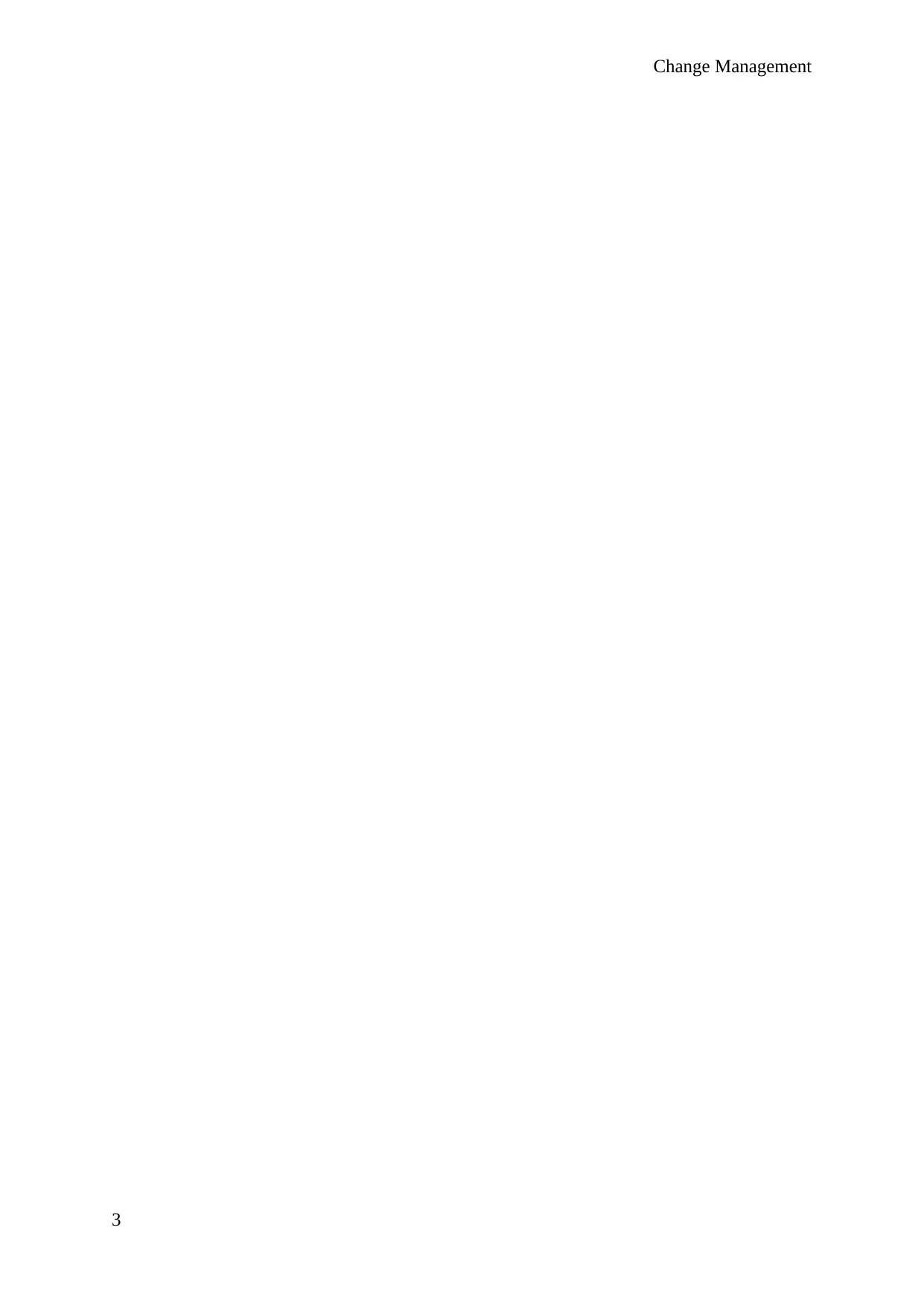
Change Management
3
3
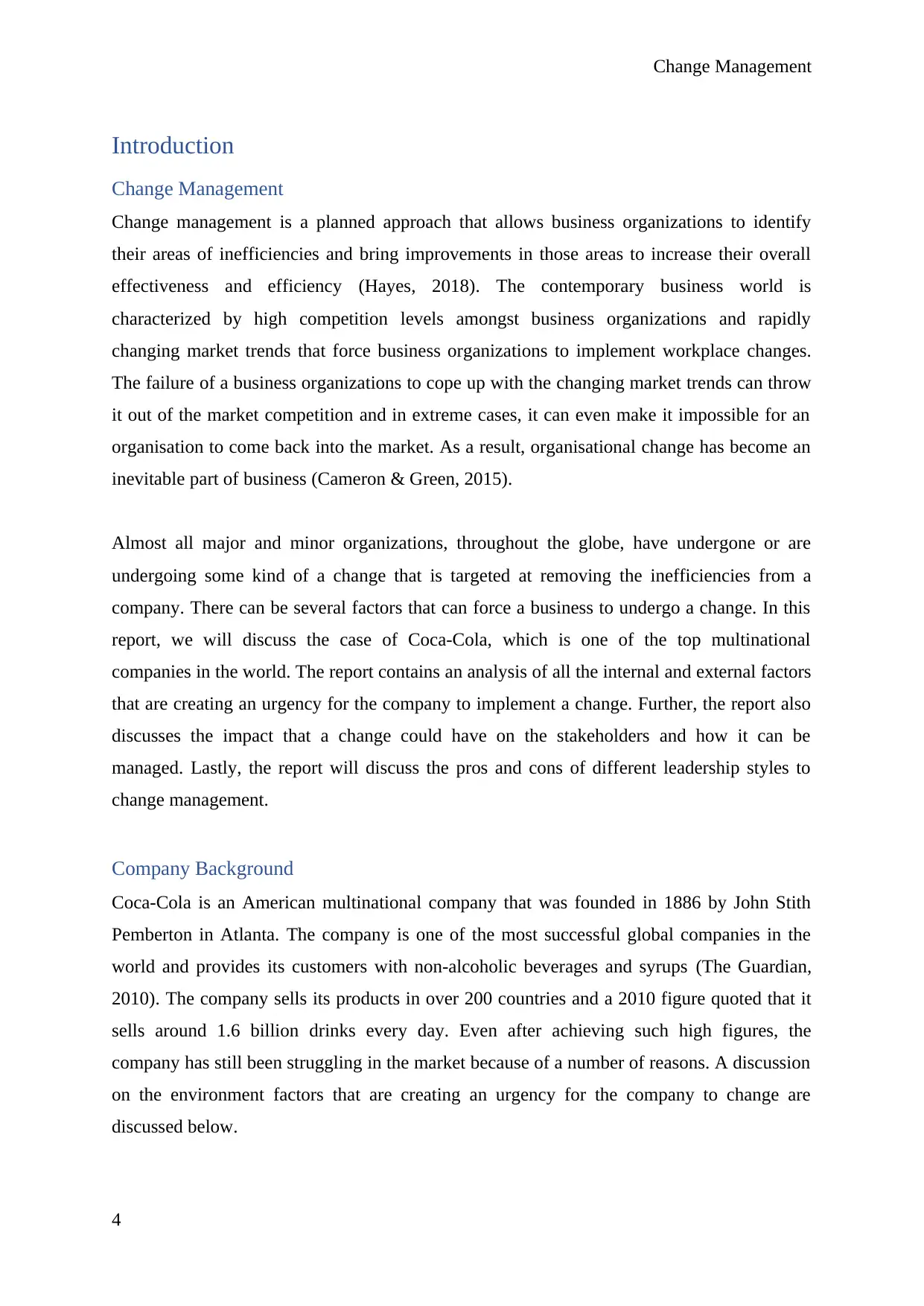
Change Management
Introduction
Change Management
Change management is a planned approach that allows business organizations to identify
their areas of inefficiencies and bring improvements in those areas to increase their overall
effectiveness and efficiency (Hayes, 2018). The contemporary business world is
characterized by high competition levels amongst business organizations and rapidly
changing market trends that force business organizations to implement workplace changes.
The failure of a business organizations to cope up with the changing market trends can throw
it out of the market competition and in extreme cases, it can even make it impossible for an
organisation to come back into the market. As a result, organisational change has become an
inevitable part of business (Cameron & Green, 2015).
Almost all major and minor organizations, throughout the globe, have undergone or are
undergoing some kind of a change that is targeted at removing the inefficiencies from a
company. There can be several factors that can force a business to undergo a change. In this
report, we will discuss the case of Coca-Cola, which is one of the top multinational
companies in the world. The report contains an analysis of all the internal and external factors
that are creating an urgency for the company to implement a change. Further, the report also
discusses the impact that a change could have on the stakeholders and how it can be
managed. Lastly, the report will discuss the pros and cons of different leadership styles to
change management.
Company Background
Coca-Cola is an American multinational company that was founded in 1886 by John Stith
Pemberton in Atlanta. The company is one of the most successful global companies in the
world and provides its customers with non-alcoholic beverages and syrups (The Guardian,
2010). The company sells its products in over 200 countries and a 2010 figure quoted that it
sells around 1.6 billion drinks every day. Even after achieving such high figures, the
company has still been struggling in the market because of a number of reasons. A discussion
on the environment factors that are creating an urgency for the company to change are
discussed below.
4
Introduction
Change Management
Change management is a planned approach that allows business organizations to identify
their areas of inefficiencies and bring improvements in those areas to increase their overall
effectiveness and efficiency (Hayes, 2018). The contemporary business world is
characterized by high competition levels amongst business organizations and rapidly
changing market trends that force business organizations to implement workplace changes.
The failure of a business organizations to cope up with the changing market trends can throw
it out of the market competition and in extreme cases, it can even make it impossible for an
organisation to come back into the market. As a result, organisational change has become an
inevitable part of business (Cameron & Green, 2015).
Almost all major and minor organizations, throughout the globe, have undergone or are
undergoing some kind of a change that is targeted at removing the inefficiencies from a
company. There can be several factors that can force a business to undergo a change. In this
report, we will discuss the case of Coca-Cola, which is one of the top multinational
companies in the world. The report contains an analysis of all the internal and external factors
that are creating an urgency for the company to implement a change. Further, the report also
discusses the impact that a change could have on the stakeholders and how it can be
managed. Lastly, the report will discuss the pros and cons of different leadership styles to
change management.
Company Background
Coca-Cola is an American multinational company that was founded in 1886 by John Stith
Pemberton in Atlanta. The company is one of the most successful global companies in the
world and provides its customers with non-alcoholic beverages and syrups (The Guardian,
2010). The company sells its products in over 200 countries and a 2010 figure quoted that it
sells around 1.6 billion drinks every day. Even after achieving such high figures, the
company has still been struggling in the market because of a number of reasons. A discussion
on the environment factors that are creating an urgency for the company to change are
discussed below.
4
Secure Best Marks with AI Grader
Need help grading? Try our AI Grader for instant feedback on your assignments.
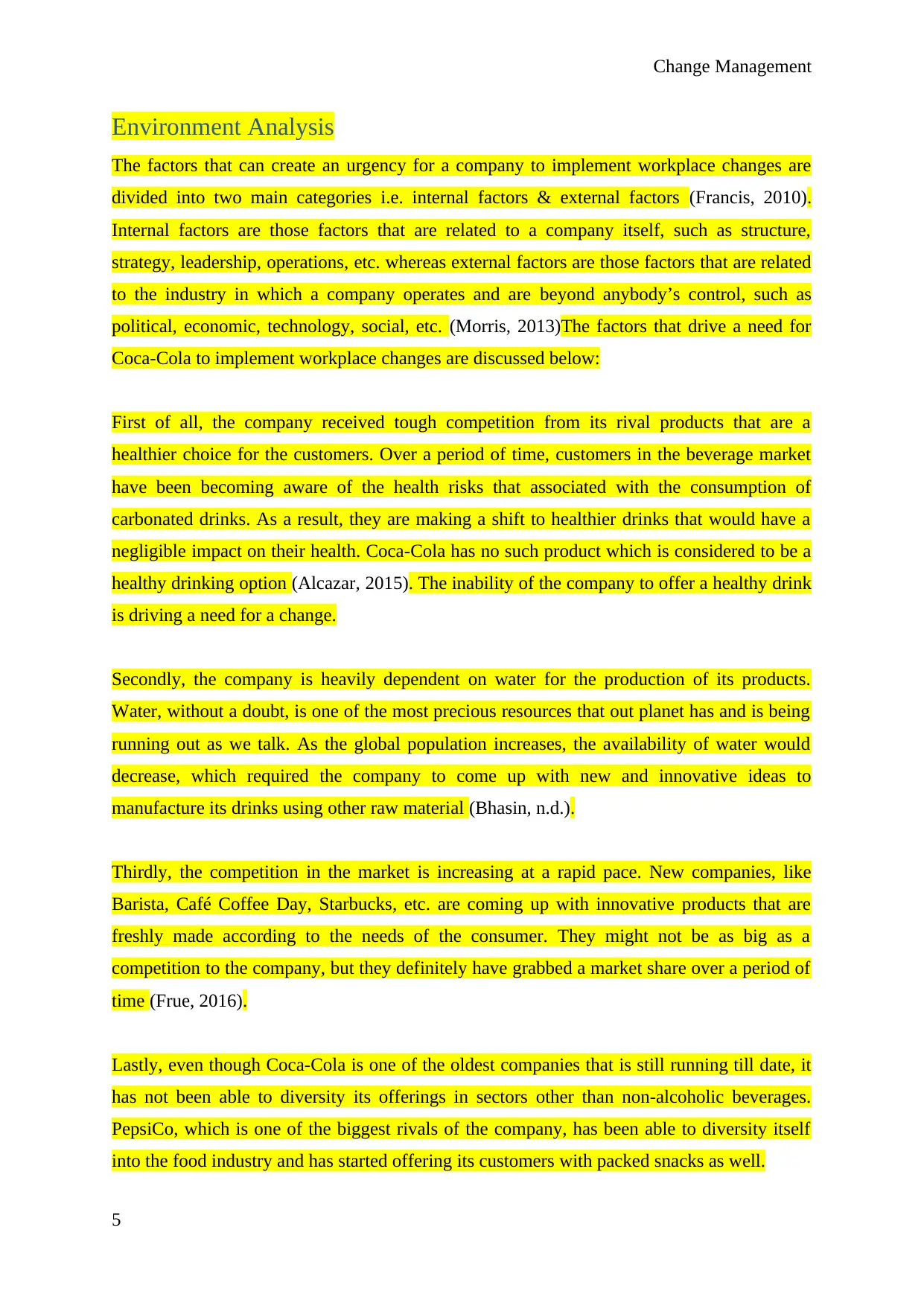
Change Management
Environment Analysis
The factors that can create an urgency for a company to implement workplace changes are
divided into two main categories i.e. internal factors & external factors (Francis, 2010).
Internal factors are those factors that are related to a company itself, such as structure,
strategy, leadership, operations, etc. whereas external factors are those factors that are related
to the industry in which a company operates and are beyond anybody’s control, such as
political, economic, technology, social, etc. (Morris, 2013)The factors that drive a need for
Coca-Cola to implement workplace changes are discussed below:
First of all, the company received tough competition from its rival products that are a
healthier choice for the customers. Over a period of time, customers in the beverage market
have been becoming aware of the health risks that associated with the consumption of
carbonated drinks. As a result, they are making a shift to healthier drinks that would have a
negligible impact on their health. Coca-Cola has no such product which is considered to be a
healthy drinking option (Alcazar, 2015). The inability of the company to offer a healthy drink
is driving a need for a change.
Secondly, the company is heavily dependent on water for the production of its products.
Water, without a doubt, is one of the most precious resources that out planet has and is being
running out as we talk. As the global population increases, the availability of water would
decrease, which required the company to come up with new and innovative ideas to
manufacture its drinks using other raw material (Bhasin, n.d.).
Thirdly, the competition in the market is increasing at a rapid pace. New companies, like
Barista, Café Coffee Day, Starbucks, etc. are coming up with innovative products that are
freshly made according to the needs of the consumer. They might not be as big as a
competition to the company, but they definitely have grabbed a market share over a period of
time (Frue, 2016).
Lastly, even though Coca-Cola is one of the oldest companies that is still running till date, it
has not been able to diversity its offerings in sectors other than non-alcoholic beverages.
PepsiCo, which is one of the biggest rivals of the company, has been able to diversity itself
into the food industry and has started offering its customers with packed snacks as well.
5
Environment Analysis
The factors that can create an urgency for a company to implement workplace changes are
divided into two main categories i.e. internal factors & external factors (Francis, 2010).
Internal factors are those factors that are related to a company itself, such as structure,
strategy, leadership, operations, etc. whereas external factors are those factors that are related
to the industry in which a company operates and are beyond anybody’s control, such as
political, economic, technology, social, etc. (Morris, 2013)The factors that drive a need for
Coca-Cola to implement workplace changes are discussed below:
First of all, the company received tough competition from its rival products that are a
healthier choice for the customers. Over a period of time, customers in the beverage market
have been becoming aware of the health risks that associated with the consumption of
carbonated drinks. As a result, they are making a shift to healthier drinks that would have a
negligible impact on their health. Coca-Cola has no such product which is considered to be a
healthy drinking option (Alcazar, 2015). The inability of the company to offer a healthy drink
is driving a need for a change.
Secondly, the company is heavily dependent on water for the production of its products.
Water, without a doubt, is one of the most precious resources that out planet has and is being
running out as we talk. As the global population increases, the availability of water would
decrease, which required the company to come up with new and innovative ideas to
manufacture its drinks using other raw material (Bhasin, n.d.).
Thirdly, the competition in the market is increasing at a rapid pace. New companies, like
Barista, Café Coffee Day, Starbucks, etc. are coming up with innovative products that are
freshly made according to the needs of the consumer. They might not be as big as a
competition to the company, but they definitely have grabbed a market share over a period of
time (Frue, 2016).
Lastly, even though Coca-Cola is one of the oldest companies that is still running till date, it
has not been able to diversity its offerings in sectors other than non-alcoholic beverages.
PepsiCo, which is one of the biggest rivals of the company, has been able to diversity itself
into the food industry and has started offering its customers with packed snacks as well.
5
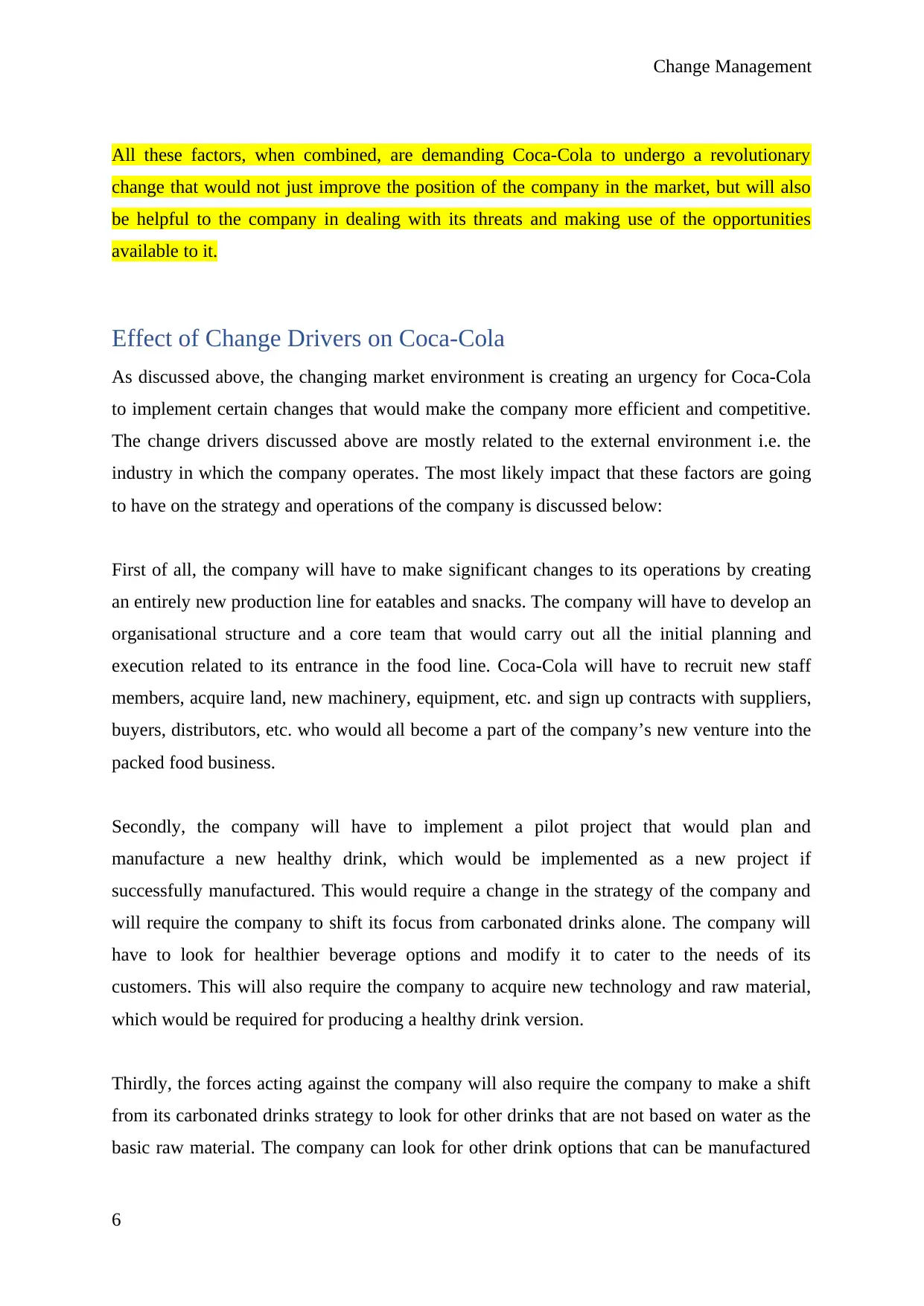
Change Management
All these factors, when combined, are demanding Coca-Cola to undergo a revolutionary
change that would not just improve the position of the company in the market, but will also
be helpful to the company in dealing with its threats and making use of the opportunities
available to it.
Effect of Change Drivers on Coca-Cola
As discussed above, the changing market environment is creating an urgency for Coca-Cola
to implement certain changes that would make the company more efficient and competitive.
The change drivers discussed above are mostly related to the external environment i.e. the
industry in which the company operates. The most likely impact that these factors are going
to have on the strategy and operations of the company is discussed below:
First of all, the company will have to make significant changes to its operations by creating
an entirely new production line for eatables and snacks. The company will have to develop an
organisational structure and a core team that would carry out all the initial planning and
execution related to its entrance in the food line. Coca-Cola will have to recruit new staff
members, acquire land, new machinery, equipment, etc. and sign up contracts with suppliers,
buyers, distributors, etc. who would all become a part of the company’s new venture into the
packed food business.
Secondly, the company will have to implement a pilot project that would plan and
manufacture a new healthy drink, which would be implemented as a new project if
successfully manufactured. This would require a change in the strategy of the company and
will require the company to shift its focus from carbonated drinks alone. The company will
have to look for healthier beverage options and modify it to cater to the needs of its
customers. This will also require the company to acquire new technology and raw material,
which would be required for producing a healthy drink version.
Thirdly, the forces acting against the company will also require the company to make a shift
from its carbonated drinks strategy to look for other drinks that are not based on water as the
basic raw material. The company can look for other drink options that can be manufactured
6
All these factors, when combined, are demanding Coca-Cola to undergo a revolutionary
change that would not just improve the position of the company in the market, but will also
be helpful to the company in dealing with its threats and making use of the opportunities
available to it.
Effect of Change Drivers on Coca-Cola
As discussed above, the changing market environment is creating an urgency for Coca-Cola
to implement certain changes that would make the company more efficient and competitive.
The change drivers discussed above are mostly related to the external environment i.e. the
industry in which the company operates. The most likely impact that these factors are going
to have on the strategy and operations of the company is discussed below:
First of all, the company will have to make significant changes to its operations by creating
an entirely new production line for eatables and snacks. The company will have to develop an
organisational structure and a core team that would carry out all the initial planning and
execution related to its entrance in the food line. Coca-Cola will have to recruit new staff
members, acquire land, new machinery, equipment, etc. and sign up contracts with suppliers,
buyers, distributors, etc. who would all become a part of the company’s new venture into the
packed food business.
Secondly, the company will have to implement a pilot project that would plan and
manufacture a new healthy drink, which would be implemented as a new project if
successfully manufactured. This would require a change in the strategy of the company and
will require the company to shift its focus from carbonated drinks alone. The company will
have to look for healthier beverage options and modify it to cater to the needs of its
customers. This will also require the company to acquire new technology and raw material,
which would be required for producing a healthy drink version.
Thirdly, the forces acting against the company will also require the company to make a shift
from its carbonated drinks strategy to look for other drinks that are not based on water as the
basic raw material. The company can look for other drink options that can be manufactured
6
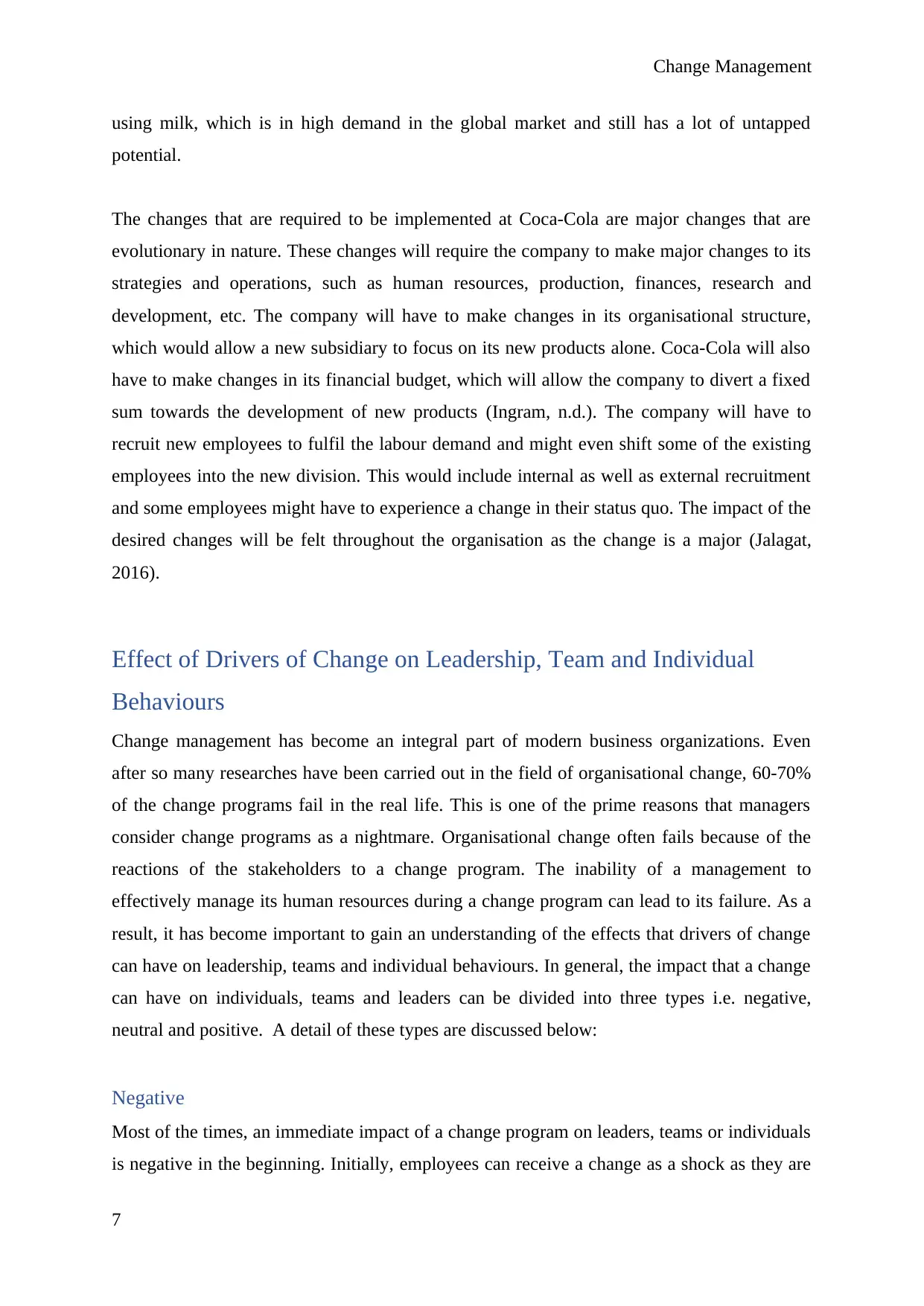
Change Management
using milk, which is in high demand in the global market and still has a lot of untapped
potential.
The changes that are required to be implemented at Coca-Cola are major changes that are
evolutionary in nature. These changes will require the company to make major changes to its
strategies and operations, such as human resources, production, finances, research and
development, etc. The company will have to make changes in its organisational structure,
which would allow a new subsidiary to focus on its new products alone. Coca-Cola will also
have to make changes in its financial budget, which will allow the company to divert a fixed
sum towards the development of new products (Ingram, n.d.). The company will have to
recruit new employees to fulfil the labour demand and might even shift some of the existing
employees into the new division. This would include internal as well as external recruitment
and some employees might have to experience a change in their status quo. The impact of the
desired changes will be felt throughout the organisation as the change is a major (Jalagat,
2016).
Effect of Drivers of Change on Leadership, Team and Individual
Behaviours
Change management has become an integral part of modern business organizations. Even
after so many researches have been carried out in the field of organisational change, 60-70%
of the change programs fail in the real life. This is one of the prime reasons that managers
consider change programs as a nightmare. Organisational change often fails because of the
reactions of the stakeholders to a change program. The inability of a management to
effectively manage its human resources during a change program can lead to its failure. As a
result, it has become important to gain an understanding of the effects that drivers of change
can have on leadership, teams and individual behaviours. In general, the impact that a change
can have on individuals, teams and leaders can be divided into three types i.e. negative,
neutral and positive. A detail of these types are discussed below:
Negative
Most of the times, an immediate impact of a change program on leaders, teams or individuals
is negative in the beginning. Initially, employees can receive a change as a shock as they are
7
using milk, which is in high demand in the global market and still has a lot of untapped
potential.
The changes that are required to be implemented at Coca-Cola are major changes that are
evolutionary in nature. These changes will require the company to make major changes to its
strategies and operations, such as human resources, production, finances, research and
development, etc. The company will have to make changes in its organisational structure,
which would allow a new subsidiary to focus on its new products alone. Coca-Cola will also
have to make changes in its financial budget, which will allow the company to divert a fixed
sum towards the development of new products (Ingram, n.d.). The company will have to
recruit new employees to fulfil the labour demand and might even shift some of the existing
employees into the new division. This would include internal as well as external recruitment
and some employees might have to experience a change in their status quo. The impact of the
desired changes will be felt throughout the organisation as the change is a major (Jalagat,
2016).
Effect of Drivers of Change on Leadership, Team and Individual
Behaviours
Change management has become an integral part of modern business organizations. Even
after so many researches have been carried out in the field of organisational change, 60-70%
of the change programs fail in the real life. This is one of the prime reasons that managers
consider change programs as a nightmare. Organisational change often fails because of the
reactions of the stakeholders to a change program. The inability of a management to
effectively manage its human resources during a change program can lead to its failure. As a
result, it has become important to gain an understanding of the effects that drivers of change
can have on leadership, teams and individual behaviours. In general, the impact that a change
can have on individuals, teams and leaders can be divided into three types i.e. negative,
neutral and positive. A detail of these types are discussed below:
Negative
Most of the times, an immediate impact of a change program on leaders, teams or individuals
is negative in the beginning. Initially, employees can receive a change as a shock as they are
7
Paraphrase This Document
Need a fresh take? Get an instant paraphrase of this document with our AI Paraphraser
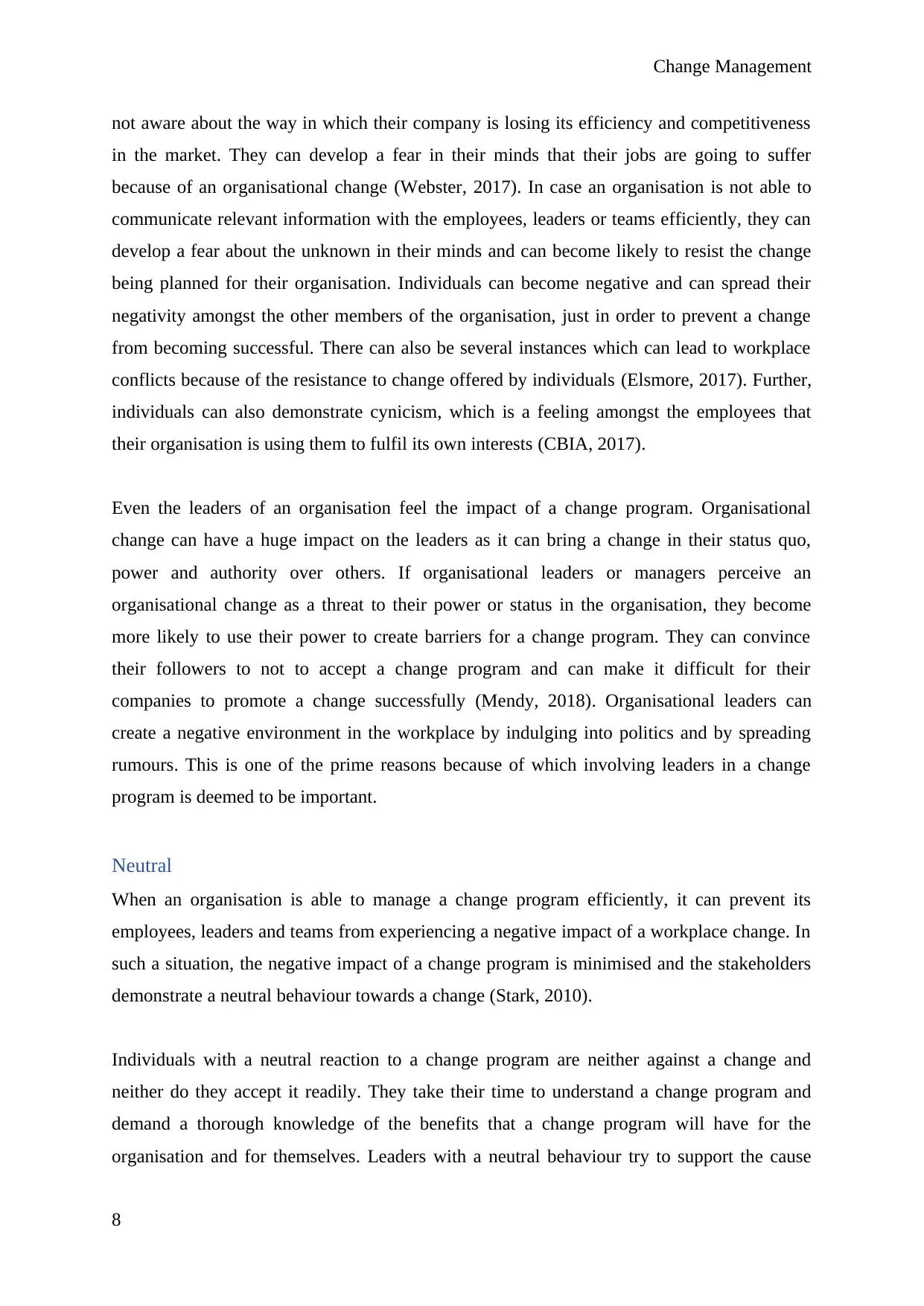
Change Management
not aware about the way in which their company is losing its efficiency and competitiveness
in the market. They can develop a fear in their minds that their jobs are going to suffer
because of an organisational change (Webster, 2017). In case an organisation is not able to
communicate relevant information with the employees, leaders or teams efficiently, they can
develop a fear about the unknown in their minds and can become likely to resist the change
being planned for their organisation. Individuals can become negative and can spread their
negativity amongst the other members of the organisation, just in order to prevent a change
from becoming successful. There can also be several instances which can lead to workplace
conflicts because of the resistance to change offered by individuals (Elsmore, 2017). Further,
individuals can also demonstrate cynicism, which is a feeling amongst the employees that
their organisation is using them to fulfil its own interests (CBIA, 2017).
Even the leaders of an organisation feel the impact of a change program. Organisational
change can have a huge impact on the leaders as it can bring a change in their status quo,
power and authority over others. If organisational leaders or managers perceive an
organisational change as a threat to their power or status in the organisation, they become
more likely to use their power to create barriers for a change program. They can convince
their followers to not to accept a change program and can make it difficult for their
companies to promote a change successfully (Mendy, 2018). Organisational leaders can
create a negative environment in the workplace by indulging into politics and by spreading
rumours. This is one of the prime reasons because of which involving leaders in a change
program is deemed to be important.
Neutral
When an organisation is able to manage a change program efficiently, it can prevent its
employees, leaders and teams from experiencing a negative impact of a workplace change. In
such a situation, the negative impact of a change program is minimised and the stakeholders
demonstrate a neutral behaviour towards a change (Stark, 2010).
Individuals with a neutral reaction to a change program are neither against a change and
neither do they accept it readily. They take their time to understand a change program and
demand a thorough knowledge of the benefits that a change program will have for the
organisation and for themselves. Leaders with a neutral behaviour try to support the cause
8
not aware about the way in which their company is losing its efficiency and competitiveness
in the market. They can develop a fear in their minds that their jobs are going to suffer
because of an organisational change (Webster, 2017). In case an organisation is not able to
communicate relevant information with the employees, leaders or teams efficiently, they can
develop a fear about the unknown in their minds and can become likely to resist the change
being planned for their organisation. Individuals can become negative and can spread their
negativity amongst the other members of the organisation, just in order to prevent a change
from becoming successful. There can also be several instances which can lead to workplace
conflicts because of the resistance to change offered by individuals (Elsmore, 2017). Further,
individuals can also demonstrate cynicism, which is a feeling amongst the employees that
their organisation is using them to fulfil its own interests (CBIA, 2017).
Even the leaders of an organisation feel the impact of a change program. Organisational
change can have a huge impact on the leaders as it can bring a change in their status quo,
power and authority over others. If organisational leaders or managers perceive an
organisational change as a threat to their power or status in the organisation, they become
more likely to use their power to create barriers for a change program. They can convince
their followers to not to accept a change program and can make it difficult for their
companies to promote a change successfully (Mendy, 2018). Organisational leaders can
create a negative environment in the workplace by indulging into politics and by spreading
rumours. This is one of the prime reasons because of which involving leaders in a change
program is deemed to be important.
Neutral
When an organisation is able to manage a change program efficiently, it can prevent its
employees, leaders and teams from experiencing a negative impact of a workplace change. In
such a situation, the negative impact of a change program is minimised and the stakeholders
demonstrate a neutral behaviour towards a change (Stark, 2010).
Individuals with a neutral reaction to a change program are neither against a change and
neither do they accept it readily. They take their time to understand a change program and
demand a thorough knowledge of the benefits that a change program will have for the
organisation and for themselves. Leaders with a neutral behaviour try to support the cause
8
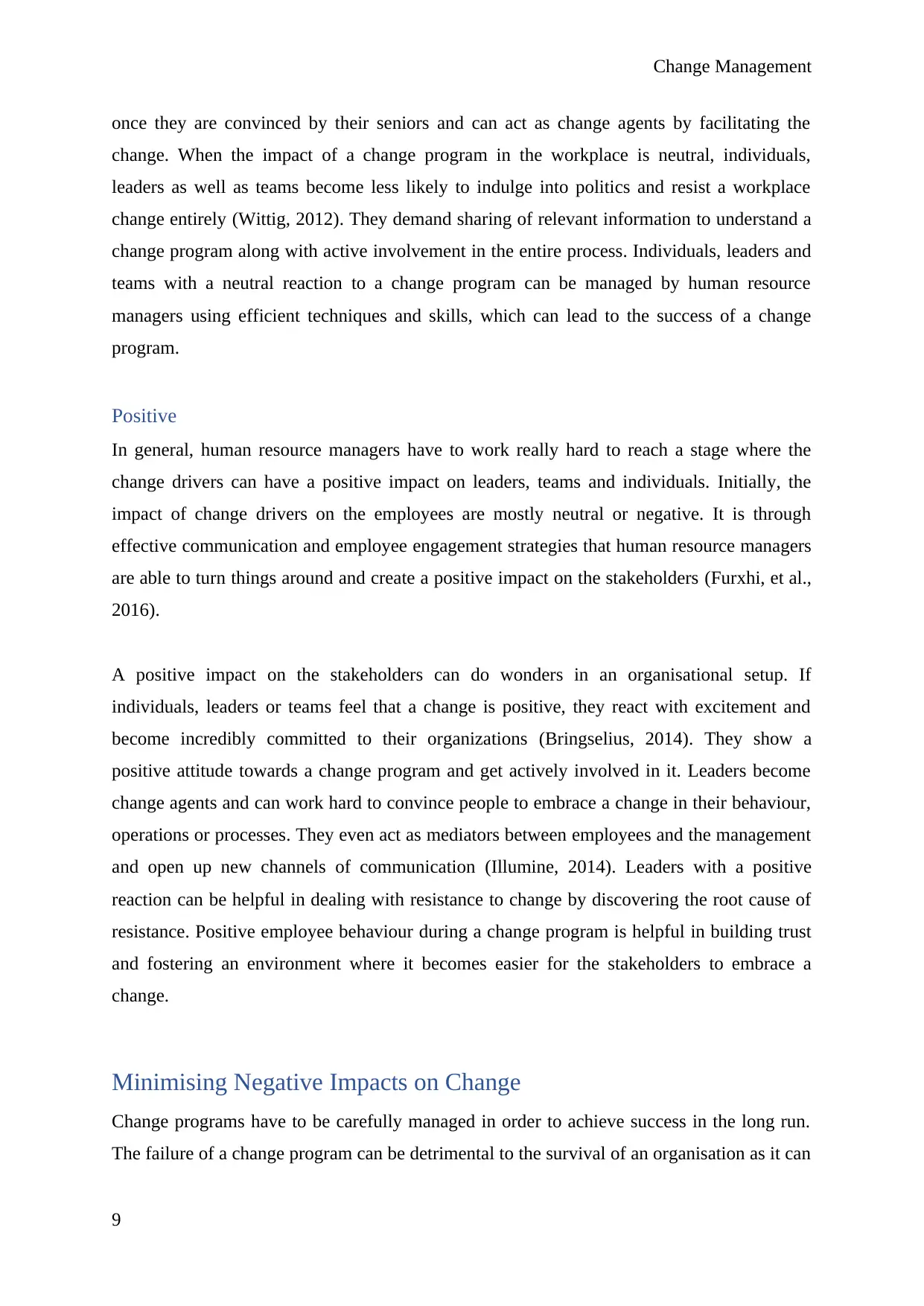
Change Management
once they are convinced by their seniors and can act as change agents by facilitating the
change. When the impact of a change program in the workplace is neutral, individuals,
leaders as well as teams become less likely to indulge into politics and resist a workplace
change entirely (Wittig, 2012). They demand sharing of relevant information to understand a
change program along with active involvement in the entire process. Individuals, leaders and
teams with a neutral reaction to a change program can be managed by human resource
managers using efficient techniques and skills, which can lead to the success of a change
program.
Positive
In general, human resource managers have to work really hard to reach a stage where the
change drivers can have a positive impact on leaders, teams and individuals. Initially, the
impact of change drivers on the employees are mostly neutral or negative. It is through
effective communication and employee engagement strategies that human resource managers
are able to turn things around and create a positive impact on the stakeholders (Furxhi, et al.,
2016).
A positive impact on the stakeholders can do wonders in an organisational setup. If
individuals, leaders or teams feel that a change is positive, they react with excitement and
become incredibly committed to their organizations (Bringselius, 2014). They show a
positive attitude towards a change program and get actively involved in it. Leaders become
change agents and can work hard to convince people to embrace a change in their behaviour,
operations or processes. They even act as mediators between employees and the management
and open up new channels of communication (Illumine, 2014). Leaders with a positive
reaction can be helpful in dealing with resistance to change by discovering the root cause of
resistance. Positive employee behaviour during a change program is helpful in building trust
and fostering an environment where it becomes easier for the stakeholders to embrace a
change.
Minimising Negative Impacts on Change
Change programs have to be carefully managed in order to achieve success in the long run.
The failure of a change program can be detrimental to the survival of an organisation as it can
9
once they are convinced by their seniors and can act as change agents by facilitating the
change. When the impact of a change program in the workplace is neutral, individuals,
leaders as well as teams become less likely to indulge into politics and resist a workplace
change entirely (Wittig, 2012). They demand sharing of relevant information to understand a
change program along with active involvement in the entire process. Individuals, leaders and
teams with a neutral reaction to a change program can be managed by human resource
managers using efficient techniques and skills, which can lead to the success of a change
program.
Positive
In general, human resource managers have to work really hard to reach a stage where the
change drivers can have a positive impact on leaders, teams and individuals. Initially, the
impact of change drivers on the employees are mostly neutral or negative. It is through
effective communication and employee engagement strategies that human resource managers
are able to turn things around and create a positive impact on the stakeholders (Furxhi, et al.,
2016).
A positive impact on the stakeholders can do wonders in an organisational setup. If
individuals, leaders or teams feel that a change is positive, they react with excitement and
become incredibly committed to their organizations (Bringselius, 2014). They show a
positive attitude towards a change program and get actively involved in it. Leaders become
change agents and can work hard to convince people to embrace a change in their behaviour,
operations or processes. They even act as mediators between employees and the management
and open up new channels of communication (Illumine, 2014). Leaders with a positive
reaction can be helpful in dealing with resistance to change by discovering the root cause of
resistance. Positive employee behaviour during a change program is helpful in building trust
and fostering an environment where it becomes easier for the stakeholders to embrace a
change.
Minimising Negative Impacts on Change
Change programs have to be carefully managed in order to achieve success in the long run.
The failure of a change program can be detrimental to the survival of an organisation as it can
9
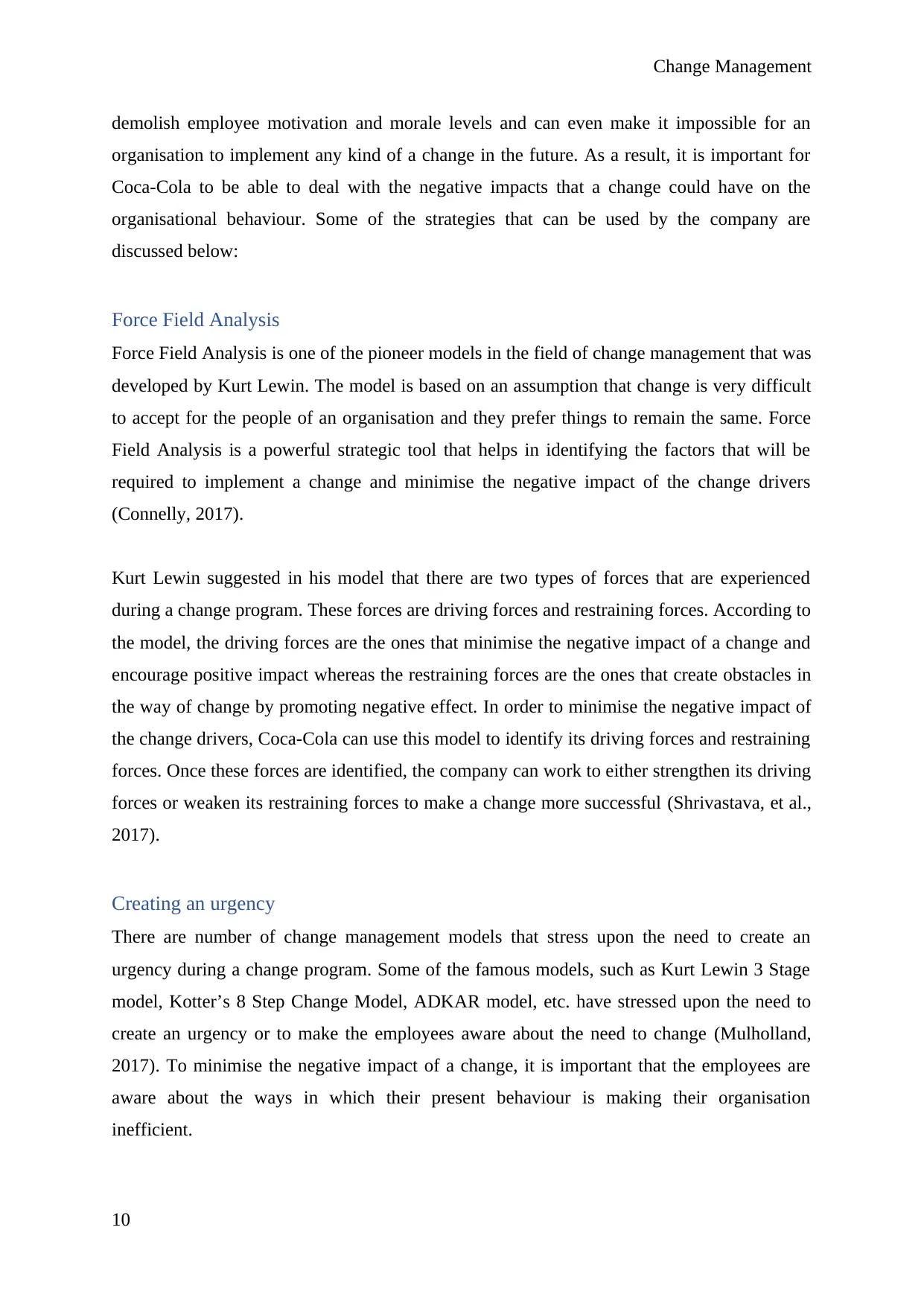
Change Management
demolish employee motivation and morale levels and can even make it impossible for an
organisation to implement any kind of a change in the future. As a result, it is important for
Coca-Cola to be able to deal with the negative impacts that a change could have on the
organisational behaviour. Some of the strategies that can be used by the company are
discussed below:
Force Field Analysis
Force Field Analysis is one of the pioneer models in the field of change management that was
developed by Kurt Lewin. The model is based on an assumption that change is very difficult
to accept for the people of an organisation and they prefer things to remain the same. Force
Field Analysis is a powerful strategic tool that helps in identifying the factors that will be
required to implement a change and minimise the negative impact of the change drivers
(Connelly, 2017).
Kurt Lewin suggested in his model that there are two types of forces that are experienced
during a change program. These forces are driving forces and restraining forces. According to
the model, the driving forces are the ones that minimise the negative impact of a change and
encourage positive impact whereas the restraining forces are the ones that create obstacles in
the way of change by promoting negative effect. In order to minimise the negative impact of
the change drivers, Coca-Cola can use this model to identify its driving forces and restraining
forces. Once these forces are identified, the company can work to either strengthen its driving
forces or weaken its restraining forces to make a change more successful (Shrivastava, et al.,
2017).
Creating an urgency
There are number of change management models that stress upon the need to create an
urgency during a change program. Some of the famous models, such as Kurt Lewin 3 Stage
model, Kotter’s 8 Step Change Model, ADKAR model, etc. have stressed upon the need to
create an urgency or to make the employees aware about the need to change (Mulholland,
2017). To minimise the negative impact of a change, it is important that the employees are
aware about the ways in which their present behaviour is making their organisation
inefficient.
10
demolish employee motivation and morale levels and can even make it impossible for an
organisation to implement any kind of a change in the future. As a result, it is important for
Coca-Cola to be able to deal with the negative impacts that a change could have on the
organisational behaviour. Some of the strategies that can be used by the company are
discussed below:
Force Field Analysis
Force Field Analysis is one of the pioneer models in the field of change management that was
developed by Kurt Lewin. The model is based on an assumption that change is very difficult
to accept for the people of an organisation and they prefer things to remain the same. Force
Field Analysis is a powerful strategic tool that helps in identifying the factors that will be
required to implement a change and minimise the negative impact of the change drivers
(Connelly, 2017).
Kurt Lewin suggested in his model that there are two types of forces that are experienced
during a change program. These forces are driving forces and restraining forces. According to
the model, the driving forces are the ones that minimise the negative impact of a change and
encourage positive impact whereas the restraining forces are the ones that create obstacles in
the way of change by promoting negative effect. In order to minimise the negative impact of
the change drivers, Coca-Cola can use this model to identify its driving forces and restraining
forces. Once these forces are identified, the company can work to either strengthen its driving
forces or weaken its restraining forces to make a change more successful (Shrivastava, et al.,
2017).
Creating an urgency
There are number of change management models that stress upon the need to create an
urgency during a change program. Some of the famous models, such as Kurt Lewin 3 Stage
model, Kotter’s 8 Step Change Model, ADKAR model, etc. have stressed upon the need to
create an urgency or to make the employees aware about the need to change (Mulholland,
2017). To minimise the negative impact of a change, it is important that the employees are
aware about the ways in which their present behaviour is making their organisation
inefficient.
10
Secure Best Marks with AI Grader
Need help grading? Try our AI Grader for instant feedback on your assignments.
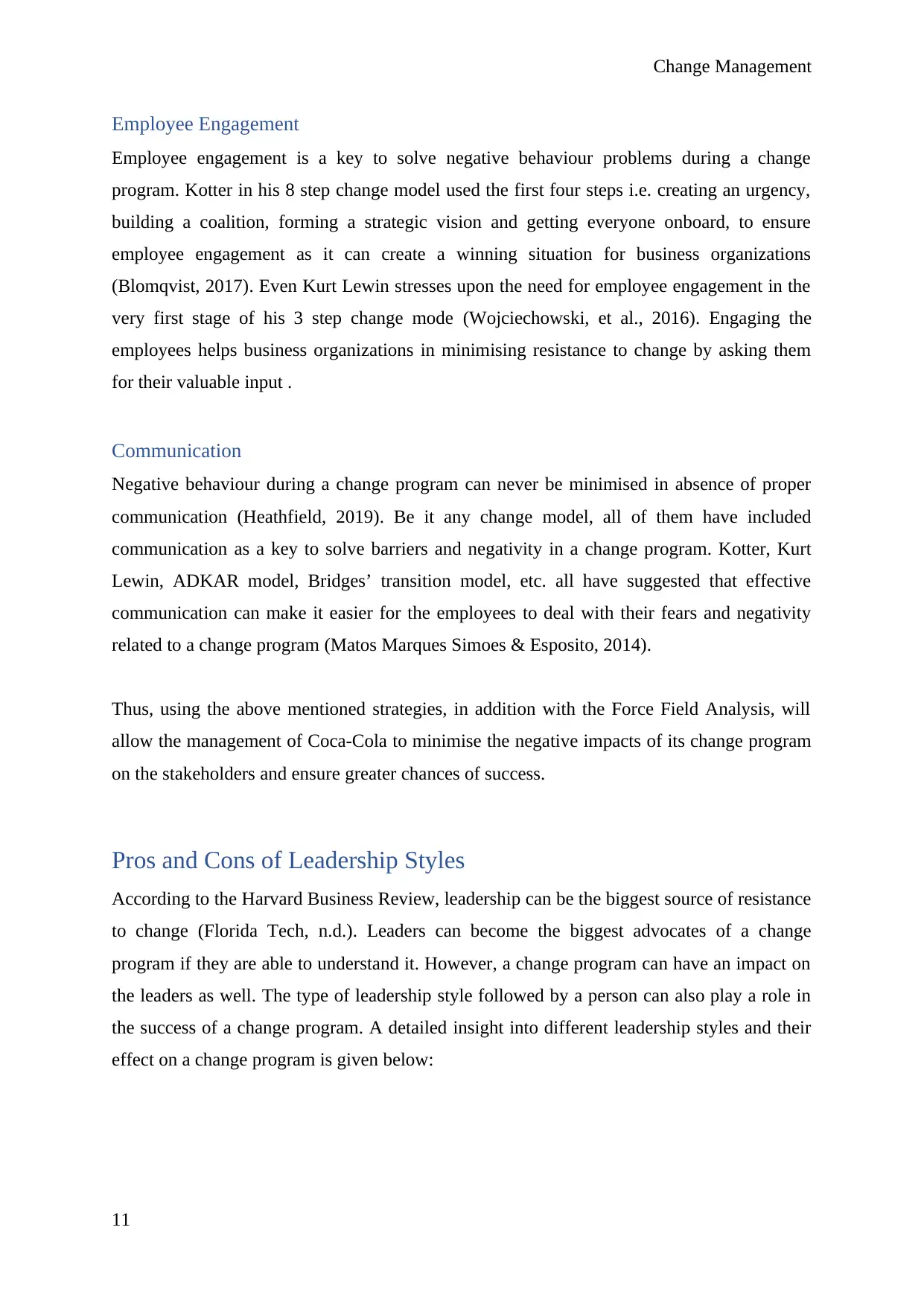
Change Management
Employee Engagement
Employee engagement is a key to solve negative behaviour problems during a change
program. Kotter in his 8 step change model used the first four steps i.e. creating an urgency,
building a coalition, forming a strategic vision and getting everyone onboard, to ensure
employee engagement as it can create a winning situation for business organizations
(Blomqvist, 2017). Even Kurt Lewin stresses upon the need for employee engagement in the
very first stage of his 3 step change mode (Wojciechowski, et al., 2016). Engaging the
employees helps business organizations in minimising resistance to change by asking them
for their valuable input .
Communication
Negative behaviour during a change program can never be minimised in absence of proper
communication (Heathfield, 2019). Be it any change model, all of them have included
communication as a key to solve barriers and negativity in a change program. Kotter, Kurt
Lewin, ADKAR model, Bridges’ transition model, etc. all have suggested that effective
communication can make it easier for the employees to deal with their fears and negativity
related to a change program (Matos Marques Simoes & Esposito, 2014).
Thus, using the above mentioned strategies, in addition with the Force Field Analysis, will
allow the management of Coca-Cola to minimise the negative impacts of its change program
on the stakeholders and ensure greater chances of success.
Pros and Cons of Leadership Styles
According to the Harvard Business Review, leadership can be the biggest source of resistance
to change (Florida Tech, n.d.). Leaders can become the biggest advocates of a change
program if they are able to understand it. However, a change program can have an impact on
the leaders as well. The type of leadership style followed by a person can also play a role in
the success of a change program. A detailed insight into different leadership styles and their
effect on a change program is given below:
11
Employee Engagement
Employee engagement is a key to solve negative behaviour problems during a change
program. Kotter in his 8 step change model used the first four steps i.e. creating an urgency,
building a coalition, forming a strategic vision and getting everyone onboard, to ensure
employee engagement as it can create a winning situation for business organizations
(Blomqvist, 2017). Even Kurt Lewin stresses upon the need for employee engagement in the
very first stage of his 3 step change mode (Wojciechowski, et al., 2016). Engaging the
employees helps business organizations in minimising resistance to change by asking them
for their valuable input .
Communication
Negative behaviour during a change program can never be minimised in absence of proper
communication (Heathfield, 2019). Be it any change model, all of them have included
communication as a key to solve barriers and negativity in a change program. Kotter, Kurt
Lewin, ADKAR model, Bridges’ transition model, etc. all have suggested that effective
communication can make it easier for the employees to deal with their fears and negativity
related to a change program (Matos Marques Simoes & Esposito, 2014).
Thus, using the above mentioned strategies, in addition with the Force Field Analysis, will
allow the management of Coca-Cola to minimise the negative impacts of its change program
on the stakeholders and ensure greater chances of success.
Pros and Cons of Leadership Styles
According to the Harvard Business Review, leadership can be the biggest source of resistance
to change (Florida Tech, n.d.). Leaders can become the biggest advocates of a change
program if they are able to understand it. However, a change program can have an impact on
the leaders as well. The type of leadership style followed by a person can also play a role in
the success of a change program. A detailed insight into different leadership styles and their
effect on a change program is given below:
11
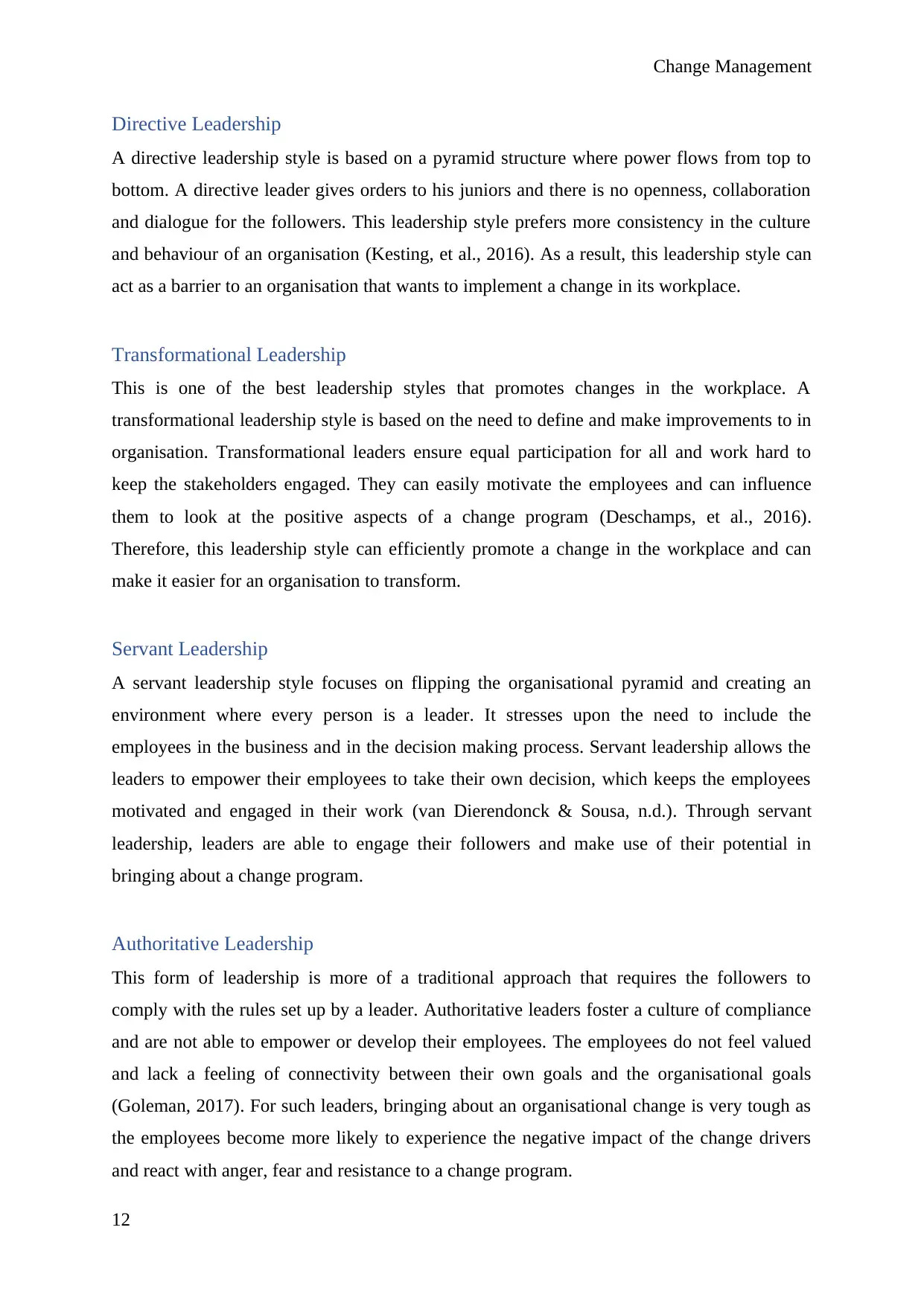
Change Management
Directive Leadership
A directive leadership style is based on a pyramid structure where power flows from top to
bottom. A directive leader gives orders to his juniors and there is no openness, collaboration
and dialogue for the followers. This leadership style prefers more consistency in the culture
and behaviour of an organisation (Kesting, et al., 2016). As a result, this leadership style can
act as a barrier to an organisation that wants to implement a change in its workplace.
Transformational Leadership
This is one of the best leadership styles that promotes changes in the workplace. A
transformational leadership style is based on the need to define and make improvements to in
organisation. Transformational leaders ensure equal participation for all and work hard to
keep the stakeholders engaged. They can easily motivate the employees and can influence
them to look at the positive aspects of a change program (Deschamps, et al., 2016).
Therefore, this leadership style can efficiently promote a change in the workplace and can
make it easier for an organisation to transform.
Servant Leadership
A servant leadership style focuses on flipping the organisational pyramid and creating an
environment where every person is a leader. It stresses upon the need to include the
employees in the business and in the decision making process. Servant leadership allows the
leaders to empower their employees to take their own decision, which keeps the employees
motivated and engaged in their work (van Dierendonck & Sousa, n.d.). Through servant
leadership, leaders are able to engage their followers and make use of their potential in
bringing about a change program.
Authoritative Leadership
This form of leadership is more of a traditional approach that requires the followers to
comply with the rules set up by a leader. Authoritative leaders foster a culture of compliance
and are not able to empower or develop their employees. The employees do not feel valued
and lack a feeling of connectivity between their own goals and the organisational goals
(Goleman, 2017). For such leaders, bringing about an organisational change is very tough as
the employees become more likely to experience the negative impact of the change drivers
and react with anger, fear and resistance to a change program.
12
Directive Leadership
A directive leadership style is based on a pyramid structure where power flows from top to
bottom. A directive leader gives orders to his juniors and there is no openness, collaboration
and dialogue for the followers. This leadership style prefers more consistency in the culture
and behaviour of an organisation (Kesting, et al., 2016). As a result, this leadership style can
act as a barrier to an organisation that wants to implement a change in its workplace.
Transformational Leadership
This is one of the best leadership styles that promotes changes in the workplace. A
transformational leadership style is based on the need to define and make improvements to in
organisation. Transformational leaders ensure equal participation for all and work hard to
keep the stakeholders engaged. They can easily motivate the employees and can influence
them to look at the positive aspects of a change program (Deschamps, et al., 2016).
Therefore, this leadership style can efficiently promote a change in the workplace and can
make it easier for an organisation to transform.
Servant Leadership
A servant leadership style focuses on flipping the organisational pyramid and creating an
environment where every person is a leader. It stresses upon the need to include the
employees in the business and in the decision making process. Servant leadership allows the
leaders to empower their employees to take their own decision, which keeps the employees
motivated and engaged in their work (van Dierendonck & Sousa, n.d.). Through servant
leadership, leaders are able to engage their followers and make use of their potential in
bringing about a change program.
Authoritative Leadership
This form of leadership is more of a traditional approach that requires the followers to
comply with the rules set up by a leader. Authoritative leaders foster a culture of compliance
and are not able to empower or develop their employees. The employees do not feel valued
and lack a feeling of connectivity between their own goals and the organisational goals
(Goleman, 2017). For such leaders, bringing about an organisational change is very tough as
the employees become more likely to experience the negative impact of the change drivers
and react with anger, fear and resistance to a change program.
12
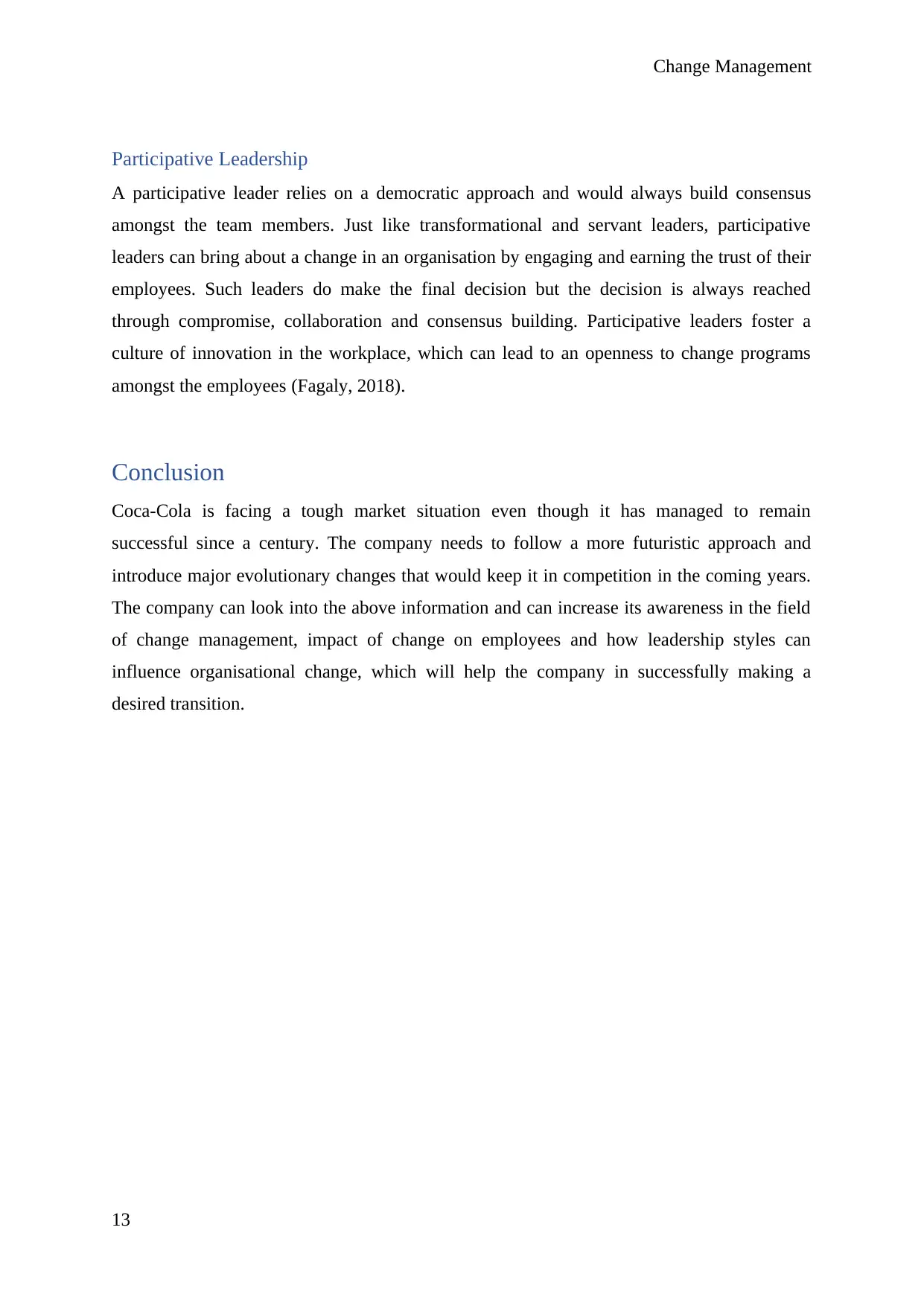
Change Management
Participative Leadership
A participative leader relies on a democratic approach and would always build consensus
amongst the team members. Just like transformational and servant leaders, participative
leaders can bring about a change in an organisation by engaging and earning the trust of their
employees. Such leaders do make the final decision but the decision is always reached
through compromise, collaboration and consensus building. Participative leaders foster a
culture of innovation in the workplace, which can lead to an openness to change programs
amongst the employees (Fagaly, 2018).
Conclusion
Coca-Cola is facing a tough market situation even though it has managed to remain
successful since a century. The company needs to follow a more futuristic approach and
introduce major evolutionary changes that would keep it in competition in the coming years.
The company can look into the above information and can increase its awareness in the field
of change management, impact of change on employees and how leadership styles can
influence organisational change, which will help the company in successfully making a
desired transition.
13
Participative Leadership
A participative leader relies on a democratic approach and would always build consensus
amongst the team members. Just like transformational and servant leaders, participative
leaders can bring about a change in an organisation by engaging and earning the trust of their
employees. Such leaders do make the final decision but the decision is always reached
through compromise, collaboration and consensus building. Participative leaders foster a
culture of innovation in the workplace, which can lead to an openness to change programs
amongst the employees (Fagaly, 2018).
Conclusion
Coca-Cola is facing a tough market situation even though it has managed to remain
successful since a century. The company needs to follow a more futuristic approach and
introduce major evolutionary changes that would keep it in competition in the coming years.
The company can look into the above information and can increase its awareness in the field
of change management, impact of change on employees and how leadership styles can
influence organisational change, which will help the company in successfully making a
desired transition.
13
Paraphrase This Document
Need a fresh take? Get an instant paraphrase of this document with our AI Paraphraser
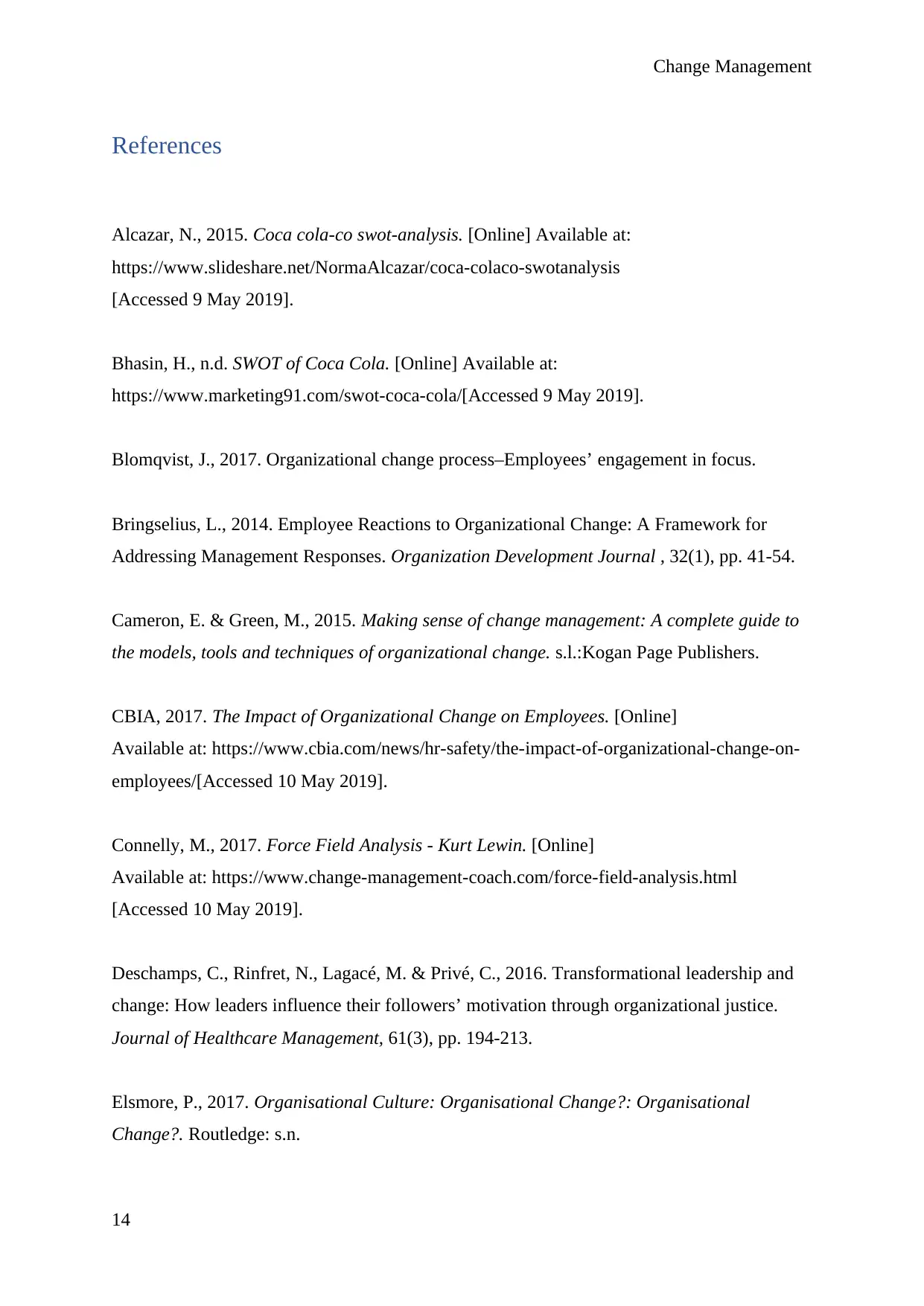
Change Management
References
Alcazar, N., 2015. Coca cola-co swot-analysis. [Online] Available at:
https://www.slideshare.net/NormaAlcazar/coca-colaco-swotanalysis
[Accessed 9 May 2019].
Bhasin, H., n.d. SWOT of Coca Cola. [Online] Available at:
https://www.marketing91.com/swot-coca-cola/[Accessed 9 May 2019].
Blomqvist, J., 2017. Organizational change process–Employees’ engagement in focus.
Bringselius, L., 2014. Employee Reactions to Organizational Change: A Framework for
Addressing Management Responses. Organization Development Journal , 32(1), pp. 41-54.
Cameron, E. & Green, M., 2015. Making sense of change management: A complete guide to
the models, tools and techniques of organizational change. s.l.:Kogan Page Publishers.
CBIA, 2017. The Impact of Organizational Change on Employees. [Online]
Available at: https://www.cbia.com/news/hr-safety/the-impact-of-organizational-change-on-
employees/[Accessed 10 May 2019].
Connelly, M., 2017. Force Field Analysis - Kurt Lewin. [Online]
Available at: https://www.change-management-coach.com/force-field-analysis.html
[Accessed 10 May 2019].
Deschamps, C., Rinfret, N., Lagacé, M. & Privé, C., 2016. Transformational leadership and
change: How leaders influence their followers’ motivation through organizational justice.
Journal of Healthcare Management, 61(3), pp. 194-213.
Elsmore, P., 2017. Organisational Culture: Organisational Change?: Organisational
Change?. Routledge: s.n.
14
References
Alcazar, N., 2015. Coca cola-co swot-analysis. [Online] Available at:
https://www.slideshare.net/NormaAlcazar/coca-colaco-swotanalysis
[Accessed 9 May 2019].
Bhasin, H., n.d. SWOT of Coca Cola. [Online] Available at:
https://www.marketing91.com/swot-coca-cola/[Accessed 9 May 2019].
Blomqvist, J., 2017. Organizational change process–Employees’ engagement in focus.
Bringselius, L., 2014. Employee Reactions to Organizational Change: A Framework for
Addressing Management Responses. Organization Development Journal , 32(1), pp. 41-54.
Cameron, E. & Green, M., 2015. Making sense of change management: A complete guide to
the models, tools and techniques of organizational change. s.l.:Kogan Page Publishers.
CBIA, 2017. The Impact of Organizational Change on Employees. [Online]
Available at: https://www.cbia.com/news/hr-safety/the-impact-of-organizational-change-on-
employees/[Accessed 10 May 2019].
Connelly, M., 2017. Force Field Analysis - Kurt Lewin. [Online]
Available at: https://www.change-management-coach.com/force-field-analysis.html
[Accessed 10 May 2019].
Deschamps, C., Rinfret, N., Lagacé, M. & Privé, C., 2016. Transformational leadership and
change: How leaders influence their followers’ motivation through organizational justice.
Journal of Healthcare Management, 61(3), pp. 194-213.
Elsmore, P., 2017. Organisational Culture: Organisational Change?: Organisational
Change?. Routledge: s.n.
14
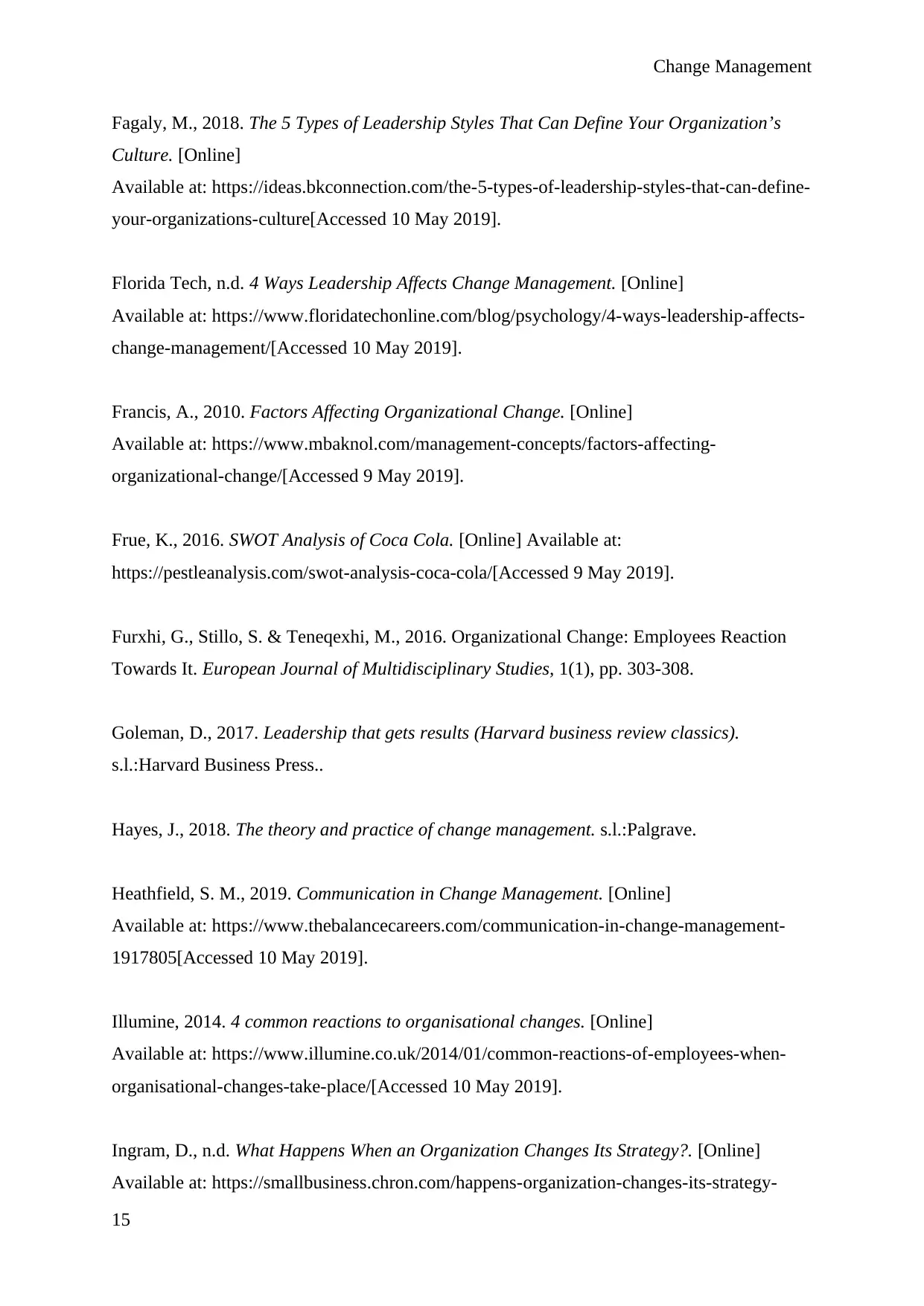
Change Management
Fagaly, M., 2018. The 5 Types of Leadership Styles That Can Define Your Organization’s
Culture. [Online]
Available at: https://ideas.bkconnection.com/the-5-types-of-leadership-styles-that-can-define-
your-organizations-culture[Accessed 10 May 2019].
Florida Tech, n.d. 4 Ways Leadership Affects Change Management. [Online]
Available at: https://www.floridatechonline.com/blog/psychology/4-ways-leadership-affects-
change-management/[Accessed 10 May 2019].
Francis, A., 2010. Factors Affecting Organizational Change. [Online]
Available at: https://www.mbaknol.com/management-concepts/factors-affecting-
organizational-change/[Accessed 9 May 2019].
Frue, K., 2016. SWOT Analysis of Coca Cola. [Online] Available at:
https://pestleanalysis.com/swot-analysis-coca-cola/[Accessed 9 May 2019].
Furxhi, G., Stillo, S. & Teneqexhi, M., 2016. Organizational Change: Employees Reaction
Towards It. European Journal of Multidisciplinary Studies, 1(1), pp. 303-308.
Goleman, D., 2017. Leadership that gets results (Harvard business review classics).
s.l.:Harvard Business Press..
Hayes, J., 2018. The theory and practice of change management. s.l.:Palgrave.
Heathfield, S. M., 2019. Communication in Change Management. [Online]
Available at: https://www.thebalancecareers.com/communication-in-change-management-
1917805[Accessed 10 May 2019].
Illumine, 2014. 4 common reactions to organisational changes. [Online]
Available at: https://www.illumine.co.uk/2014/01/common-reactions-of-employees-when-
organisational-changes-take-place/[Accessed 10 May 2019].
Ingram, D., n.d. What Happens When an Organization Changes Its Strategy?. [Online]
Available at: https://smallbusiness.chron.com/happens-organization-changes-its-strategy-
15
Fagaly, M., 2018. The 5 Types of Leadership Styles That Can Define Your Organization’s
Culture. [Online]
Available at: https://ideas.bkconnection.com/the-5-types-of-leadership-styles-that-can-define-
your-organizations-culture[Accessed 10 May 2019].
Florida Tech, n.d. 4 Ways Leadership Affects Change Management. [Online]
Available at: https://www.floridatechonline.com/blog/psychology/4-ways-leadership-affects-
change-management/[Accessed 10 May 2019].
Francis, A., 2010. Factors Affecting Organizational Change. [Online]
Available at: https://www.mbaknol.com/management-concepts/factors-affecting-
organizational-change/[Accessed 9 May 2019].
Frue, K., 2016. SWOT Analysis of Coca Cola. [Online] Available at:
https://pestleanalysis.com/swot-analysis-coca-cola/[Accessed 9 May 2019].
Furxhi, G., Stillo, S. & Teneqexhi, M., 2016. Organizational Change: Employees Reaction
Towards It. European Journal of Multidisciplinary Studies, 1(1), pp. 303-308.
Goleman, D., 2017. Leadership that gets results (Harvard business review classics).
s.l.:Harvard Business Press..
Hayes, J., 2018. The theory and practice of change management. s.l.:Palgrave.
Heathfield, S. M., 2019. Communication in Change Management. [Online]
Available at: https://www.thebalancecareers.com/communication-in-change-management-
1917805[Accessed 10 May 2019].
Illumine, 2014. 4 common reactions to organisational changes. [Online]
Available at: https://www.illumine.co.uk/2014/01/common-reactions-of-employees-when-
organisational-changes-take-place/[Accessed 10 May 2019].
Ingram, D., n.d. What Happens When an Organization Changes Its Strategy?. [Online]
Available at: https://smallbusiness.chron.com/happens-organization-changes-its-strategy-
15
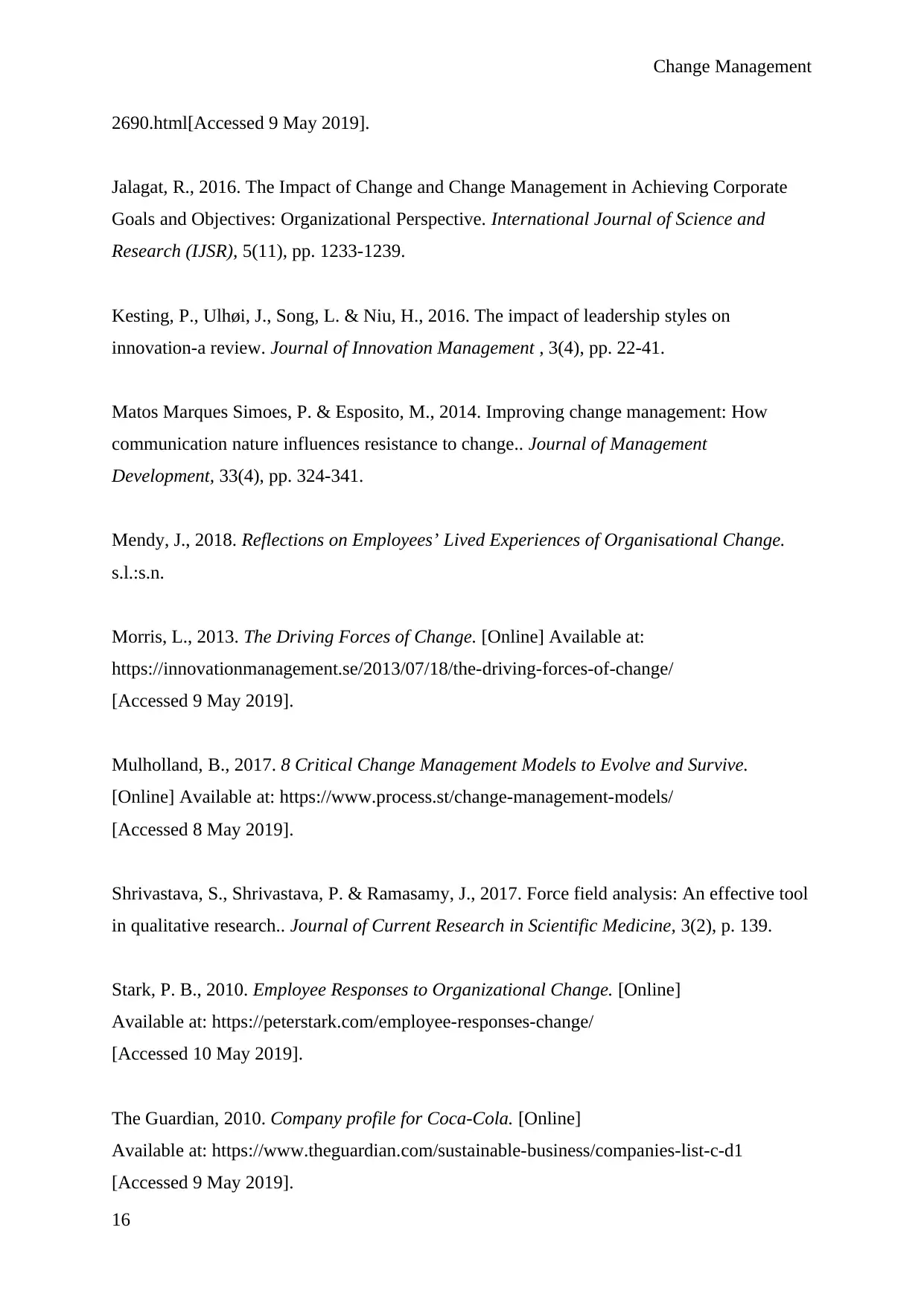
Change Management
2690.html[Accessed 9 May 2019].
Jalagat, R., 2016. The Impact of Change and Change Management in Achieving Corporate
Goals and Objectives: Organizational Perspective. International Journal of Science and
Research (IJSR), 5(11), pp. 1233-1239.
Kesting, P., Ulhøi, J., Song, L. & Niu, H., 2016. The impact of leadership styles on
innovation-a review. Journal of Innovation Management , 3(4), pp. 22-41.
Matos Marques Simoes, P. & Esposito, M., 2014. Improving change management: How
communication nature influences resistance to change.. Journal of Management
Development, 33(4), pp. 324-341.
Mendy, J., 2018. Reflections on Employees’ Lived Experiences of Organisational Change.
s.l.:s.n.
Morris, L., 2013. The Driving Forces of Change. [Online] Available at:
https://innovationmanagement.se/2013/07/18/the-driving-forces-of-change/
[Accessed 9 May 2019].
Mulholland, B., 2017. 8 Critical Change Management Models to Evolve and Survive.
[Online] Available at: https://www.process.st/change-management-models/
[Accessed 8 May 2019].
Shrivastava, S., Shrivastava, P. & Ramasamy, J., 2017. Force field analysis: An effective tool
in qualitative research.. Journal of Current Research in Scientific Medicine, 3(2), p. 139.
Stark, P. B., 2010. Employee Responses to Organizational Change. [Online]
Available at: https://peterstark.com/employee-responses-change/
[Accessed 10 May 2019].
The Guardian, 2010. Company profile for Coca-Cola. [Online]
Available at: https://www.theguardian.com/sustainable-business/companies-list-c-d1
[Accessed 9 May 2019].
16
2690.html[Accessed 9 May 2019].
Jalagat, R., 2016. The Impact of Change and Change Management in Achieving Corporate
Goals and Objectives: Organizational Perspective. International Journal of Science and
Research (IJSR), 5(11), pp. 1233-1239.
Kesting, P., Ulhøi, J., Song, L. & Niu, H., 2016. The impact of leadership styles on
innovation-a review. Journal of Innovation Management , 3(4), pp. 22-41.
Matos Marques Simoes, P. & Esposito, M., 2014. Improving change management: How
communication nature influences resistance to change.. Journal of Management
Development, 33(4), pp. 324-341.
Mendy, J., 2018. Reflections on Employees’ Lived Experiences of Organisational Change.
s.l.:s.n.
Morris, L., 2013. The Driving Forces of Change. [Online] Available at:
https://innovationmanagement.se/2013/07/18/the-driving-forces-of-change/
[Accessed 9 May 2019].
Mulholland, B., 2017. 8 Critical Change Management Models to Evolve and Survive.
[Online] Available at: https://www.process.st/change-management-models/
[Accessed 8 May 2019].
Shrivastava, S., Shrivastava, P. & Ramasamy, J., 2017. Force field analysis: An effective tool
in qualitative research.. Journal of Current Research in Scientific Medicine, 3(2), p. 139.
Stark, P. B., 2010. Employee Responses to Organizational Change. [Online]
Available at: https://peterstark.com/employee-responses-change/
[Accessed 10 May 2019].
The Guardian, 2010. Company profile for Coca-Cola. [Online]
Available at: https://www.theguardian.com/sustainable-business/companies-list-c-d1
[Accessed 9 May 2019].
16
Secure Best Marks with AI Grader
Need help grading? Try our AI Grader for instant feedback on your assignments.
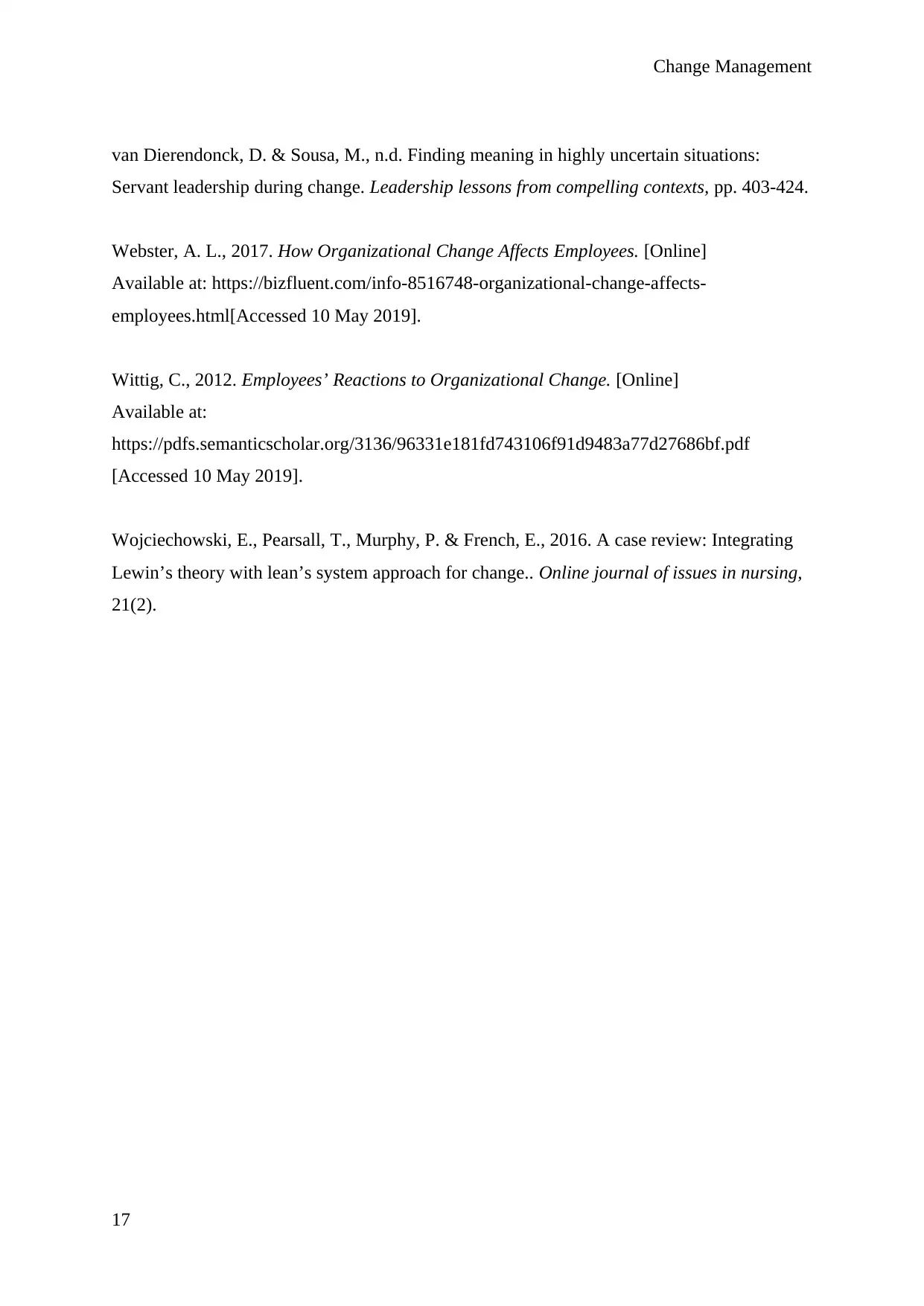
Change Management
van Dierendonck, D. & Sousa, M., n.d. Finding meaning in highly uncertain situations:
Servant leadership during change. Leadership lessons from compelling contexts, pp. 403-424.
Webster, A. L., 2017. How Organizational Change Affects Employees. [Online]
Available at: https://bizfluent.com/info-8516748-organizational-change-affects-
employees.html[Accessed 10 May 2019].
Wittig, C., 2012. Employees’ Reactions to Organizational Change. [Online]
Available at:
https://pdfs.semanticscholar.org/3136/96331e181fd743106f91d9483a77d27686bf.pdf
[Accessed 10 May 2019].
Wojciechowski, E., Pearsall, T., Murphy, P. & French, E., 2016. A case review: Integrating
Lewin’s theory with lean’s system approach for change.. Online journal of issues in nursing,
21(2).
17
van Dierendonck, D. & Sousa, M., n.d. Finding meaning in highly uncertain situations:
Servant leadership during change. Leadership lessons from compelling contexts, pp. 403-424.
Webster, A. L., 2017. How Organizational Change Affects Employees. [Online]
Available at: https://bizfluent.com/info-8516748-organizational-change-affects-
employees.html[Accessed 10 May 2019].
Wittig, C., 2012. Employees’ Reactions to Organizational Change. [Online]
Available at:
https://pdfs.semanticscholar.org/3136/96331e181fd743106f91d9483a77d27686bf.pdf
[Accessed 10 May 2019].
Wojciechowski, E., Pearsall, T., Murphy, P. & French, E., 2016. A case review: Integrating
Lewin’s theory with lean’s system approach for change.. Online journal of issues in nursing,
21(2).
17
1 out of 17
Related Documents
Your All-in-One AI-Powered Toolkit for Academic Success.
+13062052269
info@desklib.com
Available 24*7 on WhatsApp / Email
![[object Object]](/_next/static/media/star-bottom.7253800d.svg)
Unlock your academic potential
© 2024 | Zucol Services PVT LTD | All rights reserved.





